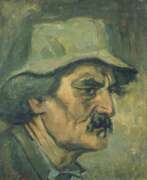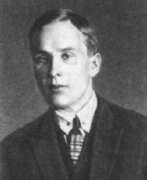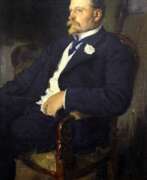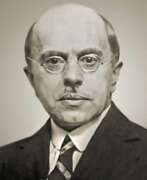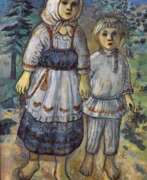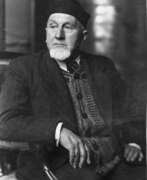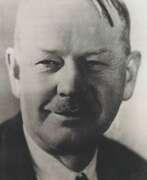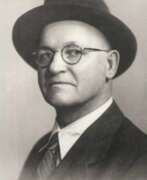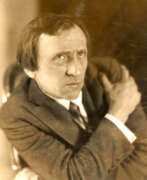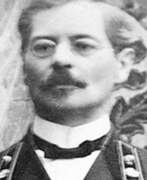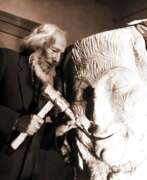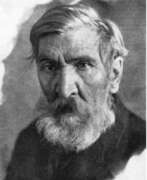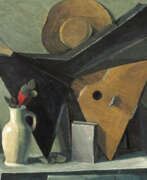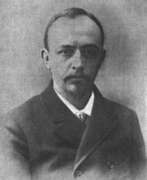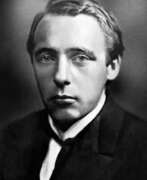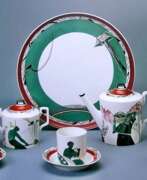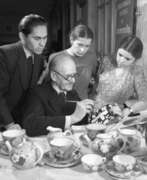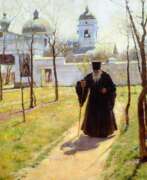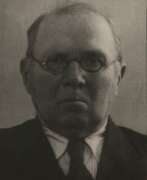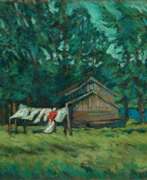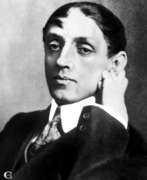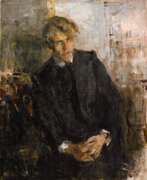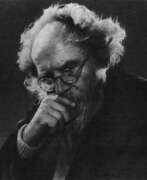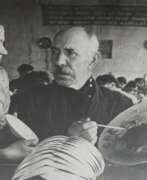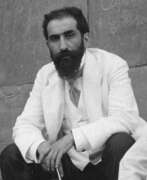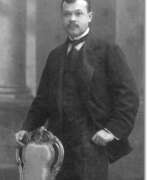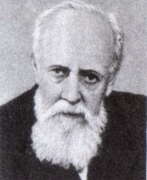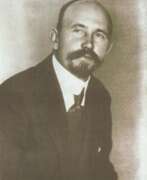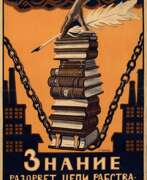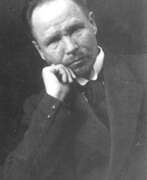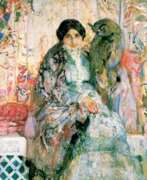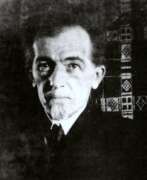USSR (1922-1991) 19th century
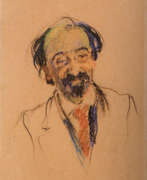

Manuel Khristoforovich Alajalov (Russian: Мануил Христофорович Аладжалов) was a prominent Russian and Soviet landscape painter and educator, born in 1862 in Nakhichevan-on-Don. Alajalov's work is distinguished by his exquisite landscapes that capture the essence of the Russian countryside. His paintings are noted for their masterful use of light and shadow, bringing a serene and lifelike quality to his depictions of nature.
Alajalov's career was marked by a deep commitment to portraying the natural world with authenticity and emotion. His art reflects a profound appreciation for the tranquility and beauty of rural Russia, making him a significant figure in the history of Russian art. Alajalov's legacy as a teacher also influenced many aspiring artists of his time, further cementing his place in the artistic community.
Alajalov's works are showcased in several major Russian museums, including the State Tretyakov Gallery, where art enthusiasts can experience his contribution to landscape painting. His paintings continue to be celebrated for their technical excellence and emotional depth, attracting collectors and admirers from around the world.
For updates on new product sales and auction events related to Manuel Khristoforovich Alajalov, sign up for our newsletter. Stay informed about exclusive opportunities to own a piece of this celebrated artist's legacy.
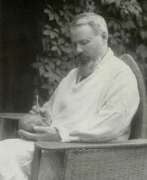

Nikolay Andreyevich Andreyev (Russian: Николай Андреевич Андреев) was a distinguished Russian sculptor, graphic artist, and stage designer, whose works have significantly contributed to the artistic landscape of early 20th-century Russia. Born into the rich cultural milieu of Moscow in 1873, Andreyev emerged as a pivotal figure associated with the Peredvizhniki group, a movement that sought realism and social critique through art. His early education under Sergey Volnukhin paved the way for a career that spanned various forms of artistic expression, including sculpture and graphic design.
Andreyev's works are known for their dynamic representation of figures and profound social commentary. Perhaps his most famous creation is the bronze statue of the celebrated writer Nikolai Gogol, unveiled in 1909. This statue, surrounded by bronze friezes depicting Gogol's characters, initially stood on Gogol Boulevard in Moscow. Its impressionistic style, however, attracted criticism, leading to its relocation in 1952. Another notable work, the "Woman reaper with a child," showcases Andreyev's adeptness at capturing the essence of Russian cultural symbols through sculpture. Cast in bronze, this work reflects Andreyev's ability to convey complex themes such as motherhood and labor with sensitivity and depth.
In his later years, Andreyev's artistic direction veered towards Socialist Realism, producing a prolific array of Leniniana - sculptures and graphic works of Vladimir Lenin. His commitment to this genre was profound, with around 100 sculptures and 200 graphic works dedicated to Lenin, marking a significant contribution to Soviet artistic propaganda. Additionally, his portrait of Lev Tolstoy stands as a testament to his versatility and depth as an artist, capturing the essence of the literary giant with striking realism.
Andreyev's legacy extends beyond his artistic achievements, with his works residing in prestigious collections such as the Tretyakov Gallery. His death in 1932 marked the end of a vibrant chapter in Russian art history, but his contributions continue to be celebrated for their artistic merit and historical significance.
For collectors and experts in art and antiques, the works of Nikolay Andreyevich Andreyev offer a unique glimpse into the cultural and political nuances of Russia during a transformative era. His sculptures not only stand as remarkable feats of artistic expression but also as enduring symbols of Russia's rich cultural heritage.
If you're intrigued by Andreyev's profound contributions to art and wish to explore his works further, consider signing up for updates. This subscription will keep you informed about new product sales and auction events related to Nikolay Andreyevich Andreyev, offering exclusive insights into the world of art and antiques.
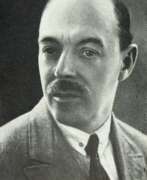

Anatoly Afanasyevich Arapov (Russian: Анатолий Афанасьевич Арапаов) was a Russian and Soviet artist, born in St. Petersburg in 1876 and passing away in Moscow in 1949. His artistic journey began after graduating from high school in 1892, leading him to study at the Moscow Boundary Institute where he initially acquired artistic skills. Arapov's dedication to art became undeniable, prompting him to enroll in the Moscow School of Painting, Sculpture and Architecture in 1897, where he was deeply involved in applied art, book design, and theater.
Arapov's early works, particularly around 1900 and 1910, were influenced by Symbolism, but he transitioned through a phase of Constructivism in the 1920s before dedicating himself to Socialist Realism from the 1930s onward. His versatile talent spanned across painting, graphic arts, and set design, making significant contributions to theater and film. Notably, he designed plays for leading theaters across major Russian cities and worked on popular films in the 1920s and 1930s.
His oeuvre includes portraits, still lifes, and landscapes, featuring views of ancient parks and Russian architecture. Arapov's works are celebrated for their stylistic diversity, capturing the essence of Symbolism, Constructivism, and Socialist Realism. His contributions are recognized in museum collections, including the State Tretyakov Gallery and the Saratov State Art Museum named after Radishchev, among others.
For collectors and art experts, Arapov's works offer a glimpse into the evolving art styles of early to mid-20th century Russia. To stay informed on sales and auction events featuring Anatoly Afanasyevich Arapov's art, signing up for updates can provide exclusive access to new discoveries and opportunities to acquire pieces by this multifaceted artist.
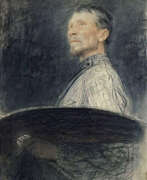

Abram Efimovich Arkhipov (Russian: Абра́м Ефи́мович Архи́пов) was a distinguished Russian realist artist, celebrated for his profound contributions to the world of art through his depictions of Russian peasantry and rural landscapes. Born in the village of Yegorovo, Ryazan Oblast, in 1862, Arkhipov's early life in a peasant family deeply influenced his thematic focus and artistic direction. His education at the Moscow School of Painting, Sculpture and Architecture, and later at the Imperial Academy of Arts, under the tutelage of prominent Russian artists such as Vasily Perov, Vasily Polenov, and Vladimir Makovsky, honed his skills and shaped his artistic vision.
Arkhipov's membership in the art collective The Wanderers and the Union of Russian Artists underscored his commitment to exploring the lives and struggles of Russian women and peasants, themes that recur throughout his work. His realist paintings often depicted the grim realities faced by these subjects, yet he also celebrated their resilience and spirit, as seen in his vibrant portrayals of peasant women in traditional dresses. Furthermore, Arkhipov's dedication to plein air painting allowed him to capture the essence of rural Russia and the northern landscapes with authenticity and emotional depth.
His notable works, such as "The Washer Women" and "Spring Holiday," are celebrated for their intricate depiction of Russian life and culture, providing viewers with a window into the soul of the Russian people. These masterpieces, along with others, have earned places in prestigious museums and galleries, including The Metropolitan Museum of Art, where his work "Ivan Rodin" from 1928 is part of their collection, symbolizing his enduring legacy in the world of art.
For collectors and experts in art and antiques, Arkhipov's works represent not only significant artistic achievements but also important cultural artifacts that offer insights into the historical and social contexts of his time. His paintings are a testament to his skill, sensitivity, and unique perspective on the Russian way of life, making him a pivotal figure in the Russian realist movement.
To stay updated on new product sales, auction events, and more insights into the world of Abram Yefimovich Arkhipov, consider signing up for updates. This subscription is a gateway to exploring the rich tapestry of Russian culture and art, as seen through the eyes of one of its most poignant chroniclers.
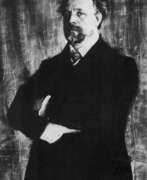

Vasily Nikolayevich Baksheyev (Russian: Василий Николаевич Бакшеев) was a distinguished Russian painter, celebrated for his contributions to landscape, interior, still life, and genre painting. His works are emblematic of the Union of Russian Artists' spirit, a movement he was closely aligned with throughout his career. Born in Moscow in 1862, Baksheyev was a prodigious talent who honed his craft at the esteemed Moscow School of Painting, Sculpture, and Architecture from 1877 to 1888, under the tutelage of luminaries such as Vladimir Makovsky, A. K. Savrasov, and V. D. Polenov. His artistic journey was marked by a significant award early on—a large silver medal for "The Return of Pilgrimage" in 1889—and travels to cultural hubs like Paris and Munich in 1895, which broadened his artistic horizons.
Baksheyev's artistry evolved over the years, from initial genre pictures to a profound exploration of landscape painting, for which he is most renowned. His works, especially from the Soviet era, continue the rich tradition of Russian lyrical landscape, imbued with a poetic quality that captures the essence of nature's transient beauty. His teaching career and efforts in organizing regional museums further underscore his commitment to art and community. Baksheyev's legacy is preserved in his poignant and luminous paintings, such as "Twilight," "Birches," and "Sunny Day," which offer a glimpse into the serene and vibrant landscapes of the Tarusa region. His work remains an invaluable part of Russia's cultural heritage, housed in numerous museums across the country and celebrated for its artistic integrity and emotional depth.
For art collectors and enthusiasts, Baksheyev's oeuvre represents a pivotal chapter in the evolution of Russian painting, characterized by its lyrical beauty and emotive power. His ability to blend impressionistic brushwork with symbolic imagery creates a unique visual language that speaks to the heart of the Russian landscape tradition.
To stay updated on new insights and opportunities related to Vasily Nikolayevich Baksheyev, including sales and auction events, signing up for updates is highly recommended. This subscription ensures that enthusiasts and collectors alike are always informed about the latest developments and available works related to this exceptional artist.
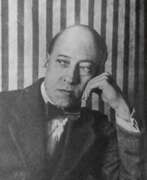

Vladimir Georgievich Bekhteev (Russian: Владимир Георгиевич Бехтеев) was a Russian artist and painter, born in 1878 and passing away in 1971. His journey into the art world led him from Russia to Munich on the advice of Sergei Jawlensky, where he was deeply influenced by the artistic and intellectual environment of the city, particularly through his connections with the Jawlensky household and the vibrant café culture. Bekhteev's early works, such as "Autumn Alley" (1905), showcase his assimilation of late Impressionist techniques and the influence of Van Gogh, reflecting a period of significant artistic development during his time in Germany.
Bekhteev's art gained recognition and was collected by prominent figures in the avant-garde art scene. His participation in exhibitions reflects a broad interest in various subjects, from landscapes to memories of Africa, demonstrating his versatility and curiosity as an artist. His works have been featured in international exhibitions and have fetched notable prices at auctions, indicating a continued interest and appreciation for his contributions to Russian and European art.
For collectors and experts in art and antiques, Bekhteev's works represent an intriguing intersection of Russian and European artistic movements in the early 20th century. His unique approach to color, form, and subject matter offers a distinctive perspective within the broader context of Impressionist and post-Impressionist art.
To stay updated on sales and auction events related to Vladimir Georgievich Bekhteev, signing up for updates is highly recommended. This subscription will ensure that enthusiasts and collectors are promptly informed of new opportunities to acquire pieces by this distinguished artist.
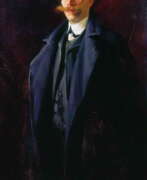

Vasiliy Vasiliyevich Belyashin (Russian: Василий Васильевич Беляшин) was a distinguished Russian and Soviet artist, acclaimed for his contributions to the Silver Age of Russian art. Born on September 8, 1874, in Vilnius, within the Russian Empire, and passing on May 8, 1929, in St. Petersburg, USSR, Belyashin's career spanned the late 19th and early 20th centuries, a period marked by significant artistic evolution. His versatility as an artist is evident in his work as a portrait painter, landscape artist, printmaker, and illustrator, with a particular renown for his series of self-portraits.
Operating mainly within the impressionist style, Belyashin's artistry was not confined to a single genre. He excelled across various forms, including landscape painting, portraits, self-portraits, and still life, showcasing a broad skill set that resonated with the Symbolist and Impressionist movements of his time. His educational background and associations with artistic societies, such as the Kuindzhi Society, the Art Community, and the Partnership of Artists, further underline his integral role in the artistic community of his era.
Though detailed records of Belyashin's works in specific museums or galleries were not immediately available, the acknowledgment of his art in auctions and the recognition by cultural institutions suggest a lasting legacy. His work, celebrated for its emotional depth and technical proficiency, continues to capture the imagination of art collectors and enthusiasts alike.
For those intrigued by Vasiliy Vasiliyevich Belyashin's unique contribution to the world of art, staying updated on auctions and exhibitions featuring his work is invaluable. Signing up for updates related to Belyashin can ensure you remain informed about new sales and auction events, offering a chance to connect more deeply with this master's artistic journey.
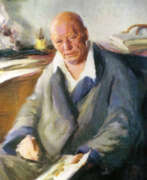

Pavel Petrovich Benkov (Russian: Павел Петрович Беньков) was a Russian and Soviet artist of the first half of the twentieth century. He is known as a painter, graphic artist, theater decorator, and teacher.
Pavel Benkov created portraits, landscapes, cityscapes, genre paintings. His style in his mature years can be described as impressionist, with attention to color and light. In 1929 he moved to Central Asia, where his style took on unique characteristics, reflecting local landscapes and culture. His work has had a significant influence on the painting traditions of Uzbekistan and Central Asia.
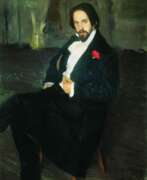

Ivan Yakovlevich Bilibin (Russian: Ива́н Я́ковлевич Били́бин) was a Russian illustrator, stage designer, and teacher, famed for his fairy tale illustrations and stage designs that drew heavily from Russian folklore and traditional art. Born in 1876 in St. Petersburg and passing away in 1942 during the Siege of Leningrad, Bilibin's career spanned a period of great change in Russia, from the pre-revolutionary times through to the Soviet era. His work is celebrated for its intricate detail, vibrant colors, and deep homage to Slavic myths and legends.
Bilibin's journey into the world of art and folklore began after his studies at the St. Petersburg University and the Munich art school. He was deeply influenced by Russian folklore, as well as modern French and Japanese art. This amalgamation of influences resulted in a unique style that made his work stand out. His illustrations for Russian folk tales, such as "The Frog Princess," "Vasilisa the Beautiful," and "Marya Morevna," are among his most celebrated works, encapsulating the essence of Russian narrative traditions.
Bilibin's career was not confined to illustration. He made significant contributions to the world of theater, designing sets for operas and ballets that further entrenched his reputation. His work took him beyond Russia, with periods spent in Egypt and France, where he continued to produce work for the Russian émigré and European communities. Despite the political turmoil of his time, Bilibin remained deeply connected to his roots, returning to Soviet Russia in 1936, where he continued his artistic and academic pursuits until his death in 1942.
For collectors and experts in art and antiques, Bilibin's works represent a bridge between the mystical past and the artistic innovations of the early 20th century. His legacy is preserved in museums and galleries worldwide, offering a glimpse into a world where folklore and art intertwine.
If you are keen to explore more about Ivan Yakovlevich Bilibin's remarkable contributions to art and folklore, consider signing up for updates. This subscription will keep you informed about new sales, auctions, and exhibitions related to Bilibin's work, ensuring you never miss an opportunity to engage with the magical worlds he created.
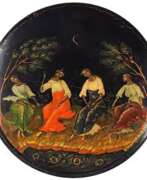

Aleksandr Ivanovich Blokhin was a Russian Soviet painter.
Alexander Ivanovich Blokhin was engaged in painting icons for several decades. In 1925-1928 he worked in the Palekh artyel of ancient painting. He painted papier-mâché items (caskets, cigarette cases, powder pots) on literary subjects, also executed genre and battle compositions.
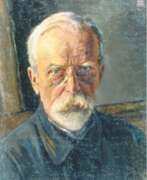

Yulii Yulyevich Blumenthal (Russian: Юлий Юльевич Блюменталь) was a Russian and Soviet artist of the first half of the twentieth century of German origin. He is known as a painter and graphic artist who played an important role in the development of Bashkir fine arts.
Yulii Blumenthal created portraits, landscapes and genre works, including those reflecting the culture and life of the Bashkir people, such as "Bashkir Rider" and "Behind Shearing Sheep". Being the director of the Bashkir State Art Museum in 1926-1935, the master played a significant role in laying the foundations of professional museum accounting and documentation.


Grigory Mikhailovich Bobrovsky (Russian: Григорий Михайлович Бобровский) was a distinguished Russian painter born in Vitebsk in 1873 and passed away in Leningrad in 1942. His academic journey in the arts began at the prestigious Academy of Arts under the tutelage of Ilya Repin between 1893 and 1900, where he honed his craft and graduated with the title of artist for his painting "Evening." By 1916, Bobrovsky was recognized as an academician, contributing significantly to the Russian art scene with his evocative landscapes and scenes capturing early 20th-century life.
Bobrovsky's artwork is celebrated for its free manner of painting, decorative expressiveness of color, attention to lighting effects, and the fragmentariness of composition. His works, which were influenced by both the Union of Russian Artists and the Mir Iskusstva movement, spanned a variety of themes, including landscapes and scenes dedicated to the Revolution and life in the USSR. Notable works include "Early Spring" (1922), "Night at Sea" (1923), and "The Road" (1927), showcasing his mastery over light and color.
His contributions to Russian art were recognized through exhibitions during his lifetime and posthumously, with retrospective exhibitions held in Leningrad (1947) and Perm (2001). Bobrovsky's works are part of several prestigious collections, including the State Tretyakov Gallery, the State Russian Museum, and the Perm State Art Gallery, evidencing his lasting impact on the art world.
For art collectors and experts, Grigory Mikhailovich Bobrovsky's oeuvre offers a profound insight into the evolution of Russian painting in the early 20th century. His ability to capture the essence of his era through vibrant colors and expressive compositions makes his work a valuable addition to any collection.
To stay updated on new product sales and auction events related to Grigory Mikhailovich Bobrovsky's works, sign up for updates. This subscription will keep you informed about opportunities to acquire pieces by this remarkable artist, ensuring you don't miss out on adding a piece of Russian art history to your collection.


Konstantin Fyodorovich Bogaevsky (Russian: Константин Фёдорович Богаевский), a Russian painter renowned for his Symbolist landscapes, was a significant figure in the art world between the late 19th and early 20th centuries. Born in Feodosia, Crimea, to an old Italian-German family, Bogaevsky's initial art education came from Ivan Aivazovsky. His formative years were spent at the Imperial Academy of Arts under Arkhip Kuindzhi, where despite facing criticism and temporary expulsion for "lack of talent," Kuindzhi's protection and faith in his abilities paved the way for Bogaevsky's future successes.
Bogaevsky's travels to Italy and France in 1898 introduced him to the works of Claude Lorrain, who Bogaevsky considered his true mentor. This experience, coupled with a later discovery of Andrea Mantegna's paintings in 1911, significantly influenced his work. His artistry is noted for its dream-like symbolist landscapes, often of an imaginary land known among his circle as "Bogaevia." Maximilian Voloshin's essays, titled "Konstantin Bogaevsky," played a crucial role in popularizing Bogaevsky's work, drawing parallels between him and Nicholas Roerich.
Throughout his career, Bogaevsky was affiliated with several art groups, including Mir iskusstva, Union of Russian Artists, and Zhar-Tsvet. His exhibitions, notably the 1906 Exposition de l'Art Russe organized by Sergei Diaghilev, highlighted his unique blend of Symbolism and later influences from Renaissance masters like Mantegna, Dürer, and Altdorfer. Despite the October Revolution driving him into relative obscurity, Bogaevsky's legacy as a master of Symbolist landscapes endures, with works like the 1932 "Port of an Imaginable City" still celebrated for their artistic value.
Bogaevsky's works are represented in major museums, including the Tretyakov Gallery, Russian Museum, and Feodosia Art Gallery. His death in Feodosia during a Soviet air raid in 1943 left behind a legacy enriched by his exploration of historical landscapes and symbolist vistas, immortalizing him as a visionary of his time.
For collectors and experts in art and antiques, Bogaevsky's oeuvre offers a fascinating journey into the melding of historical reverence and symbolist imagination. His works, steeped in the influences of European masters and his unique vision of an imaginary land, continue to captivate and inspire. To stay updated on exhibitions and auction events featuring Konstantin Fyodorovich Bogaevsky's work, signing up for updates is highly recommended. This subscription will ensure you are always informed about new sales and the opportunity to own a piece of this historical and symbolist art legacy.


Osip Emmanuilovich Braz (Russian: Осип Эммануилович Браз) was a Russian-Jewish realist painter, celebrated for his adeptness in portraying the subtleties of human character and the serene beauty of landscapes. Born in Odessa in 1873, Braz embarked on his artistic journey at the Odessa Art School, later honing his craft in Munich under the guidance of Sandor Kholloshi and in St. Petersburg at the Academy of Arts, where he studied under the legendary Ilya Repin. His early works, marked by a series of compelling portraits, including those of eminent Russian cultural figures like Anton Chekhov, garnered him significant acclaim. Braz's portrait of Chekhov, commissioned by Pavel Tretyakov for the State Tretyakov Gallery, is particularly noted for being the only complete lifetime portrait of the writer.
Braz's contributions to art were not confined to portraiture alone; he also produced exquisite still lifes and landscapes, capturing the essence of his subjects with a delicacy and depth that reflected his mastery over the medium. His landscapes of France, Crimea, and Finland, inspired by his travels, exhibit a remarkable sense of place and mood, blending realism with an impressionistic sensitivity to light and color.
Throughout his career, Braz was deeply involved in the art community, participating in the World of Art exhibitions and influencing the artistic dialogue of his time. Despite facing adversity, including imprisonment and the confiscation of his art collections by Soviet authorities, Braz's legacy as a painter and collector endures. His works continue to be celebrated for their technical prowess and emotional depth, held in high esteem by collectors and experts alike.
For collectors and experts in art and antiques, Osip Emmanuilovich Braz's oeuvre offers a window into the soul of Russian realism and the broader currents of European art at the turn of the century. His life's work underscores the enduring power of art to capture the human condition and the natural world in all their complexity and beauty. Sign up for updates to stay informed about new product sales and auction events related to Osip Emmanuilovich Braz and delve deeper into the legacy of this remarkable artist.
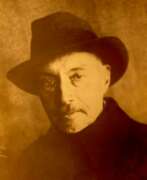

Nikolai Evlampievich Bublikov (Russian: Николай Евлампиевич Бубликов) was a Russian and Soviet artist of the late 19th and first half of the 20th centuries. He is known as a marine and landscape painter, a representative of the Leningrad school of painting.
Nikolai Bublikov was distinguished by the use of a wide spatial perspective and a subtle range of colors in his works. He is considered the first artist who in his work raised the theme of the Soviet Navy. During the Great Patriotic War, the artist stayed in Leningrad and died during the siege of the city.
His works can be found in various museums and private collections in Russia and abroad, including the Russian Museum and the Central Naval Museum in St. Petersburg.


Fyodor Fyodorovich Buchholz (Russian: Фёдор Фёдорович Бухгольц) was a Russian artist of German origin in the late 19th century and the first half of the 20th century. He is known as a painter, graphic artist and teacher.
Fyodor Buchholz painted mainly on historical themes and genre paintings, as well as portraits and landscapes. At the end of the XIX century, the artist was fascinated by Art Nouveau. After the revolution of 1917 he began to create works on the themes of social construction.
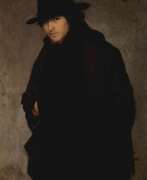

Philipp Antonovich Chirko (Russian: Филипп Антонович Чирко) was a Russian and Ukrainian painter, born on July 3, 1859, in Kyiv. Chirko was known for his realistic style and was associated with the Peredvizhniki movement, a group of artists committed to social realism and traveling exhibitions. He studied at the Kyiv Drawing School and later at the Imperial Academy of Arts in Saint Petersburg, graduating in 1892.
Chirko’s works often depicted battle scenes, genre paintings, and landscapes of Ukraine. Notable paintings include "The Pursuit of French Mounted Chasseurs by the Horse Guards under Polotsk on August 6, 1812," which is part of the Borodino Panorama Museum's collection in Moscow. Unfortunately, many of his works were lost during World War II.
Chirko’s remaining works are highly valued by collectors and can be found in various Russian museums, including the Chernihiv Art Museum. His contribution to art is significant for its historical and artistic value, capturing the essence of his era.
Sign up for updates related to Philipp Antonovich Chirko to receive notifications about new product sales and auction events.
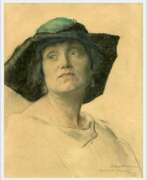

Olga Lyudvigovna Della-Vos-Kardovskaya (Russian: Ольга Людвиговна Делла-Вос Кардовская) was a Russian painter and graphic artist, whose works and life story continue to fascinate art collectors and experts. Born in Chernigov in the Russian Empire in 1875 and passing away in Leningrad, USSR in 1952, Della-Vos-Kardovskaya's artistic journey was marked by rigorous training and profound experiences. Her educational path took her from the Schneider School in Kharkov to the Academy in Saint Petersburg, and finally to Munich, where she studied under Anton Ažbe. The year 1900 was significant for her, marking not only a milestone in her artistic education but also her marriage to the painter Dmitry Kardovsky.
Della-Vos-Kardovskaya's career was characterized by her participation in various artist societies and exhibitions, significantly contributing to her recognition in the art world. Between 1903 and 1917, she exhibited her work with the New Society of Artists and the Union of Russian Artists. Her association with the Zhar-tsvet group from 1924 to 1928 and her inclusion in a significant 1927 exhibit in Moscow commemorating the tenth anniversary of the Russian Revolution highlight her active involvement in the artistic movements of her time.
Her body of work includes a variety of subjects, from self-portraits to notable figures such as Nikolay Gumilyov and Anna Akhmatova, demonstrating her versatility and skill as both a painter and a graphic artist. These works, alongside her contributions to Russian art movements and exhibitions, underscore her lasting impact on the art world.
For collectors and experts in art and antiques, Olga Lyudvigovna Della-Vos-Kardovskaya's work represents not only a connection to the rich history of Russian art but also an opportunity to appreciate the depth and breadth of her artistic contributions. To stay updated on sales and auction events related to Della-Vos-Kardovskaya's work, signing up for updates is highly recommended, ensuring access to the latest information and opportunities to acquire pieces by this distinguished artist.
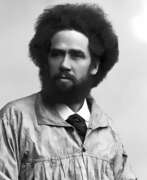

Aleksey Kuzmich Denisov-Uralsky (Russian: Алексей Кузьмич Денисов-Уральский) was a Russian artist and stonecutter, born in 1864 and known for his exceptional landscape paintings and intricate stone carvings. He made significant contributions to both the artistic and jewelry worlds, particularly in Russia during the late 19th and early 20th centuries.
Denisov-Uralsky's works are celebrated for their meticulous craftsmanship and vibrant use of color. His paintings often depicted the serene landscapes of the Ural Mountains, capturing their natural beauty with a delicate touch. Notable pieces include "River Landscape" and "Author's Boat by the High Wooded Bank of the Chusovaya," both of which have fetched impressive prices at auctions, reflecting their enduring appeal.
In addition to his paintings, Denisov-Uralsky was renowned for his work with semi-precious stones. He founded a prominent firm in St. Petersburg, where he created exquisite jewelry and decorative items. One of his famous works, an imperial hardstone figure of a parrot, showcases his ability to transform natural stones into lifelike sculptures. This piece was even purchased by Dowager Empress Maria Feodorovna, underscoring its high value and artistry.
Collectors and art enthusiasts continue to admire Denisov-Uralsky's legacy, which combines the elegance of Russian landscapes with the precision of fine stonework. His works remain sought after at auctions and are displayed in various prestigious collections worldwide.
For updates on new product sales and auction events related to Aleksey Kuzmich Denisov-Uralsky, sign up for our notifications. Stay informed about opportunities to acquire pieces by this exceptional artist.
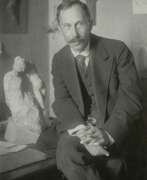

Vladimir Nicholaevich Domogatsky (Russian: Владимир Николаевич Домогацкий) was a Russian sculptor, teacher, and Honored Art Worker of the RSFSR, known for his contribution to the development of Soviet sculpture. Born in Odessa in 1876 and spending his early years in Switzerland and Ukraine, Domogatsky's life and career were predominantly centered in Moscow. He studied law at Moscow University and then took up sculpture under the tutelage of S.M. Volnukhin and S.V. Ivanov. Domogatsky's work was greatly influenced by the works of P. P. Trubetskiy, Auguste Rodin, the animalist painter R. Bugatti and others. Travels to Paris and Italy contributed to the improvement of his skills, especially in working with marble.
Domogatsky's work was diverse: genre, animalistic and portrait sculpture. Notable works include Boy in a Coat (1904), Portrait of an Old Actor (1913), and Portrait of Lev Shestov (1917), demonstrating his skill in merging Russian sculptural traditions with Western European influences. Teaching at the Moscow Institute of Fine Arts, organizing and participating in exhibitions all attest to his significant influence on the Soviet art scene. His works are held in prestigious museums, including the State Tretyakov Gallery, reflecting his enduring legacy in Russian art.
For collectors and experts, Domogatsky's sculptures represent a unique combination of historical and cultural narrative, embodied in the subtlety of his craftsmanship. His contributions to monumental propaganda and theoretical developments in sculpture further cement his status as a key figure in 20th century Soviet art.
To keep abreast of exhibitions and auctions featuring works by Vladimir Nikolayevich Domogatsky, we encourage you to subscribe to our updates. By subscribing, you will be the first to know about new sales and auction events related to this esteemed artist and enrich your collection with items of significant historical and artistic value.
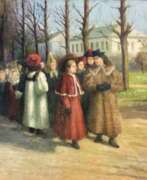

Ivan Osipovich Dudin (Russian: Иван Осипович Дудин) was a Russian and Soviet artist, painter, translator, and educator. He was born on January 19, 1867, in Moscow and passed away on April 4, 1924, in the same city. Dudin received his education at Moscow University and the Moscow School of Painting, Sculpture, and Architecture, where he was awarded the title of class artist in 1902.
Dudin is known for his landscapes, portraits, and genre scenes. His extensive travels influenced his works significantly. Since 1894, he regularly participated in exhibitions of the Moscow Society of Art Lovers and the Association of Traveling Art Exhibitions. Among his notable students were famous artists such as A.V. Kuprin, V.A. Favorsky, and V.I. Mukhina.
One of Dudin's significant works is "Blooming Garden" from 1902, which is exhibited in the State Tretyakov Gallery. His works can also be found in museums in Irkutsk, Kirov, and Krasnodar.
If you want to receive updates on new sales and auction events related to Ivan Osipovich Dudin, sign up for our updates. We will inform you only about new arrivals and events related to this artist.
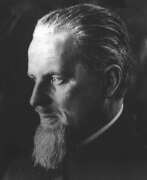

Ivan Semyonovich Efimov (Russian: Иван Семёнович Ефимов) was a Russian and Soviet artist of the first half of the twentieth century. He is known as an animal painter, graphic artist, sculptor, illustrator and reformer of the puppet theater.
Ivan Efimov worked in different genres and techniques, but all his work, including decorative and applied art, was focused on animalistic themes. He created works for the Moscow subway, train stations, sanatoriums and many other places and became famous for his technique of through volume relief in sculpture. The master also illustrated more than 20 books.
Efimov also created erotic works - about a thousand sheets with various thematic series, but the public learned about them only after the collapse of the USSR.
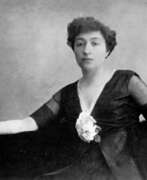

Aleksandra Aleksandrovna Ekster (Russian: Алекса́ндра Алекса́ндровна Эксте́р), a luminary of the Russian avant-garde, was a painter and designer whose work traversed the boundaries of Cubo-Futurism, Suprematism, and Constructivism, eventually influencing the Art Deco movement. Born in Białystok (then part of the Russian Empire, now Poland) and later splitting her life among Kiev, St. Petersburg, Moscow, Vienna, and Paris, Ekster played a pivotal role in bridging Russian and European artistic movements. Her innovative approach to art was characterized by dynamic movement, vibrant color contrasts, and geometric compositions, which were evident in her paintings, theater set and costume designs, and educational endeavors.
Ekster's studio became a hub for the intellectual and artistic elite, hosting figures like poets Anna Akhmatova and Osip Mandelstam, as well as painters Pablo Picasso and Georges Braque during her stays in Paris. Her involvement in significant art exhibitions, such as the Salon des Indépendants and the Salon de la Section d'Or in Paris, showcased her works alongside those of Jean Metzinger, Marcel Duchamp, and others, marking her as a key figure in the avant-garde community.
Beyond painting, Ekster's contributions to theater and design were profound. She worked on costume and set designs for Alexander Tairov's Chamber Theatre and participated in the revolutionary festivities' decoration in Kiev and Odessa. Ekster's pedagogical efforts included teaching at the Higher Artistic-Technical Workshop (VKhUTEMAS) in Moscow, fostering a new generation of avant-garde artists.
Ekster's work is housed in various international and private collections, reflecting her lasting impact on the art world. Her ability to integrate different genres and styles, along with her commitment to experimentation and innovation, made her one of the most influential women in the Russian avant-garde.
For those fascinated by the pioneering spirit of Aleksandra Aleksandrovna Ekster and the avant-garde movement, signing up for updates on new product sales and auction events related to her work is a compelling way to stay informed. This subscription ensures enthusiasts and collectors are always in the loop regarding opportunities to engage with Ekster's enduring legacy.


Mitrofan Semyonovich Fedorov (Russian: Митрофан Семёнович Фёдоров) was a Russian and Soviet artist of the first half of the twentieth century. He is known as a painter and teacher.
Mitrofan Fedorov painted thematic paintings, landscapes, portraits. He was an adherent of academic approach, but at the same time he was searching in art and supported the avant-garde. In Kharkov, where the artist lived and worked for more than 30 years, he was a member of the group of artists "Koltso", close in its principles to the pioneers of the avant-garde in Russia - the "Jack of Diamonds" group.
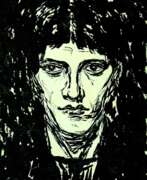

Nikolai Petrovich Feofilaktov (Russian: Николай Петрович Феофилактов) was a Russian graphic artist and a prominent figure in the Moscow art Nouveau and symbolism movements. Born in Moscow in 1878, Feofilaktov was a self-taught artist in painting and music, deeply influenced by Mikhail Vrubel and the graphics of Western European Jugendstil. Notably, in 1904, he participated in the "Scarlet Rose" exhibition, establishing connections with the "Blue Rose" artists and participating in their exhibitions. Feofilaktov was notably influenced by the work of Aubrey Beardsley, earning him the nickname "Moscow Beardsley" or "bergsmannen" due to his intricate and diletante style. His graphic work, characterized by its whimsical and slightly naive depiction of morbid fantasies, masks, and mythical creatures, was well-received for its artistic merit and distinctive Moscow style plasticity.
After 1910, Feofilaktov's popularity waned, and he shifted his focus to painting, working in the publishing house "Academia" from 1933 to 1937. His early success was marked by his association with the magazine "Vesy" and the Symbolist movement in Moscow, showcasing his ability to blend graphic art with literary culture. Feofilaktov's work was a critical reflection of the spirit and aspirations of Russian symbolism's "second wave," highlighting his significant contributions to Russian graphic art and symbolist literature.
Feofilaktov's artworks have been recognized and valued in the art market, with his pieces being auctioned and collected internationally. This recognition underscores the enduring appeal and historical significance of his contributions to Russian art and symbolism.
For collectors and experts in art and antiques, Nikolai Petrovich Feofilaktov's work represents a unique blend of Russian symbolism and Moscow art Nouveau, making his pieces highly sought after. His influence on and contributions to the Russian art scene during a pivotal period in its development continue to be celebrated and studied. To stay updated on new product sales and auction events related to Feofilaktov, sign up for updates. This subscription will ensure that you are informed about opportunities to acquire works by this distinguished artist.


Alexander Fedorovich Gaush (Russian: Александр Фёдорович Гауш), born in 1873 and passing away in 1947, was a distinguished Russian painter whose contributions to art spanned various genres and styles, with a particular emphasis on landscape and still life paintings. His education under the tutelage of prominent artists like P. P. Chistyakov and at the St. Petersburg Academy of Arts, as well as his time at the Académie Julian in Paris, played a significant role in shaping his artistic direction. Gaush's involvement with the "New Society of Artists" and the "World of Art" association highlighted his active engagement with the artistic movements of his time.
Gaush's teaching career in institutions across Petrograd, Sevastopol, and Odessa further underscores his dedication to nurturing the next generation of artists. His works, celebrated for their vivid portrayal of the Russian and Crimean landscapes, are housed in art galleries and museums across Russia, Ukraine, and other countries, testament to his lasting influence and the appreciation of his talent on a global scale.
Collectors and art experts continue to value Gaush's artworks for their historical significance and the unique perspective they offer on the landscapes he depicted. His works, often featured in auctions, reflect not only his skill and versatility but also the rich cultural and artistic heritage of his time.
For enthusiasts keen on exploring Gaush's legacy or adding his works to their collections, staying informed about new sales and auction events is crucial. Signing up for updates related to Alexander Fedorovich Gaush can ensure you don't miss out on the opportunity to own a piece of this illustrious artist's legacy.


Aleksandr Mikhailovich Gerasimov (Russian: Алекса́ндр Миха́йлович Гера́симов) was a Russian and Soviet painter, born on August 12, 1881, in Kozlov (now Michurinsk), in the Tambov Governorate of the Russian Empire. He is best recognized for his leading role in promoting socialist realism in visual arts, notably through his portraits of Joseph Stalin and other Soviet leaders. Gerasimov's education at the Moscow School of Painting, Sculpture, and Architecture honed his skills, guided by masters like K.A. Korovin, A.E. Arkhipov, and V.A. Serov. His style, a blend of academic realism with impressionistic influences, vividly depicted the Russian landscape, leaders, and the daily life of the Soviet era.
His works, rich in emotionality and composition mastery, span across various themes from state portraits to landscapes and still lifes, showcasing a deep love for the Russian landscape's innate beauty. Gerasimov's contributions to art include not only significant political portraits but also captivating scenes of nature and life in Russia, marked by their emotional depth and vibrant colors. His paintings like "Stalin and Voroshilov in the Kremlin" won him the Stalin Prize in 1941, cementing his status in Soviet art history.
Gerasimov's artistry extends beyond his political work; his landscapes and portrayals of Russian expanses convey a deep lyrical sentiment, reflecting his profound connection and love for his homeland. His mastery across various mediums—oil, watercolor, gouache, and more—allowed him to explore and express a wide range of subjects, from portraits and landscapes to still lifes, showcasing his versatility and depth as an artist.
For those interested in the intersection of art and history, Aleksandr Mikhailovich Gerasimov's work offers a fascinating window into Soviet-era Russia, its leaders, and its landscapes. To stay updated on exhibitions and sales of Gerasimov's works, sign up for updates specifically focused on new product sales and auction events related to this distinguished artist.
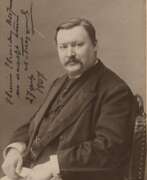

Aleksandr Konstantinovich Glazunov (russian: Александр Константинович Глазунов) was a Russian late Romantic composer, conductor and teacher.
Glazunov belonged to a well-known dynasty of book publishers in St. Petersburg and showed musical ability early on. He studied music with Balakirev and Rimsky-Korsakov, wrote his first symphony at the age of sixteen, and was noticed by the patron of the arts Mitrofan Belyaev, who became his admirer and benefactor. Thanks to him, the young Glazunov traveled all over Europe and was introduced in Weimar to Franz Liszt, who promoted the performance of his First Symphony at the congress of the General German Musical Union.
After the death of composer Borodin, Glazunov helped Rimsky-Korsakov finish his opera Prince Igor, and in the late 1890s he was already collaborating with the Imperial Theaters and writing three ballets. In 1899 Glazunov was appointed professor at the St. Petersburg Conservatory, and from the end of 1905 he became its director, retaining this post even after the October Revolution of 1917. Glazunov's personality is characterized by the fact that he spent his director's salary on helping poor students. And in general, during the hungry years of post-revolutionary devastation, he supported students, even if he did not share their musical beliefs - among them the greats Sergei Prokofiev and Dmitri Shostakovich.
In 1922, Aleksandr Glazunov was named People's Artist of the young Soviet republic. In 1928 he traveled to Vienna to take part in the jury of the Schubert Centenary Composition Competition and never returned to the USSR. However, even while living in Europe, he retained his Soviet citizenship. Officially, Glazunov's stay in Paris was explained by his serious state of health and the need for medical treatment. Already in 1972 Glazunov's ashes were transported to the USSR and reburied in the Alexander Nevsky Lavra.
In addition to ballets, Aleksandr Glazunov wrote eight symphonies (the ninth remained unfinished), seven string quartets and a great deal of orchestral music. He wrote mainly for piano and organ, and at the end of his life he composed works for saxophone - a solo concerto and a quartet for saxophones. Glazunov's most popular works today are his ballets The Seasons (1898) and Raymonda (1897), his Fourth, Fifth and Sixth Symphonies, the Polonaise from Les Sylphides, and his two concert waltzes.
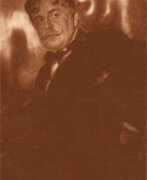

Aleksandr Yakovlevich Golovin (Russian: Алекса́ндр Я́ковлевич Голови́н) was a distinguished Russian artist and stage designer, celebrated for his vibrant and ornate creations in the realms of theatre and fine arts. Born in Moscow in 1863, Golovin initially pursued architecture before shifting his focus to painting, a move that enriched Russian art with his unique blend of symbolism and modernism. His academic journey took him from the Moscow School of Painting, Sculpture and Architecture to the Académie Colarossi in Paris, marking the beginning of a prolific career that intertwined Russian heritage with avant-garde European influences.
Golovin's artistic signature is evident in his stage designs for prominent figures like Sergei Diaghilev, Constantin Stanislavski, and Vsevolod Meyerhold. His work for the original production of Stravinsky's "The Firebird" ballet and the scenic design for Beaumarchais's "The Marriage of Figaro" at the Moscow Art Theatre showcases his ability to blend visual splendor with dramatic storytelling. Beyond the theatre, Golovin's paintings, such as portraits of Fyodor Chaliapin and Vsevolod Meyerhold, and works like "Porcelain and flowers" and "Silver willows," display his mastery over color and form, capturing the essence of Russian culture and the beauty of the natural world.
A figure of national pride, Golovin was honored as a People's Artist of the RSFSR, a testament to his significant contribution to Russian art and culture. His legacy continues to inspire, with his works preserved in the Russian Museum among other collections, serving as a testament to his enduring influence on Russian artistic expression.
For collectors and experts in art and antiques, Aleksandr Yakovlevich Golovin represents a pivotal figure in the evolution of Russian visual arts and stage design. His contributions to both fields remain invaluable, reflecting a unique blend of cultural heritage and innovative artistry. For updates related to Golovin, including new product sales and auction events, signing up for updates offers an exclusive insight into the world of this remarkable artist.
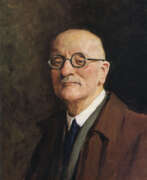

Igor Emmanuilovich Grabar (Russian: И́горь Эммануи́лович Граба́рь) was a distinguished Russian painter, art historian, and museum administrator, whose contributions have left an indelible mark on the world of art. Renowned for his versatility, Grabar was not only a masterful artist but also a visionary in art preservation and education. His work reflects a deep appreciation for Russia's cultural heritage, capturing the essence of its landscapes, historical moments, and architectural beauty with a unique blend of realism and impressionism.
Grabar's significance extends beyond his paintings; he played a pivotal role in the preservation of Russian art, overseeing restoration projects and establishing guidelines that are still in use today. His efforts in cataloging and promoting Russian art helped to elevate the profile of Russian culture on the global stage. Among his well-known works, "February Azure" stands out for its captivating use of color and light, showcasing Grabar's skill in conveying the beauty of Russian winters.
As an educator and museum director, Grabar influenced generations of artists and art historians, embedding a deep respect for artistic heritage and innovation. His leadership at the Tretyakov Gallery and involvement in various art schools helped to shape the direction of Russian art in the 20th century. Grabar's legacy is not just in his artworks but also in his contributions to art education and museum practices, making him a revered figure among collectors, experts, and enthusiasts of art and antiques.
For those passionate about the rich tapestry of Russian art and culture, Igor Emmanuilovich Grabar's work remains a source of inspiration and admiration. We invite collectors and art experts to sign up for updates on new product sales and auction events related to Grabar's work. This subscription is your gateway to the world of a visionary artist whose influence continues to resonate in the art world.
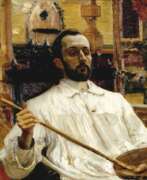

Dmitry Nicolajevich Kardovsky (Russian: Дмитрий Николаевич Кардовский) was a Russian artist, illustrator, and stage designer, celebrated for his multifaceted contributions to the world of art. Born in 1866 near Pereslavl-Zalessky, Kardovsky initially pursued law at Moscow University before devoting himself to art at the Imperial Academy of Arts under the tutelage of Pavel Chistyakov and Ilya Repin. His educational journey included a period in Munich, studying with Anton Ažbe, which enriched his artistic approach, combining Russian and European influences.
Kardovsky is perhaps best known for his mastery in drawing and book illustration. His work, characterized by a deep understanding of the literature he illustrated, brought to life the narratives and characters of Russian literary classics by Chekhov, Gogol, Lermontov, and Tolstoy, among others. His illustrations for works such as "Kashtanka" by Anton Chekhov and "Nevsky Prospekt" by Gogol are particularly noted for their vivid expression and delicate precision.
Beyond his illustrative prowess, Kardovsky made significant contributions as an educator, imparting his knowledge to a generation of artists who went on to have distinguished careers of their own. His commitment to teaching was exemplified by an exhibition in 1929, where the majority of the works displayed were by his students, underscoring his influence and legacy in Russian art education.
Kardovsky's work extended to the theater, where he created costumes and scenery, notably for the Maly Theatre in productions of Ostrovsky and Turgenev. His engagement with historical themes was also prominent, with series of paintings reflecting key periods in Russian history, demonstrating his versatility and deep connection to his cultural heritage.
His latter years were spent in Pereslavl-Zalessky, where he continued to produce landscapes and portraits, capturing the essence of Central Russia and its inhabitants with a particular fondness and respect. Kardovsky's work remains an integral part of Russian and Soviet art history, bridging the styles of the Silver Age with post-revolutionary traditionalism.
For those interested in exploring the rich tapestry of Russian art and the pivotal role played by Dmitry Kardovsky, signing up for updates on new product sales and auction events related to his work is highly recommended. This subscription ensures enthusiasts and collectors alike stay informed about opportunities to engage with Kardovsky's enduring legacy.
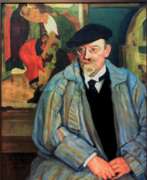

Ivan Semyonovich Kazakov (Russian: Иван Семёнович Казаков) was a Russian painter and graphic artist, known for his contributions to Orientalist art. Born on February 1, 1873, in Kasilova, Oryol Governorate, Kazakov studied at the Moscow School of Painting, Sculpture, and Architecture, and later at the Imperial Academy of Arts under the mentorship of Vladimir Makovsky.
Kazakov's work is notable for its vibrant depictions of Central Asian architecture and landscapes, particularly those of Samarkand, Bukhara, and Tashkent. His paintings often feature detailed portrayals of domes, minarets, and intricate patterns, capturing the essence of these historic cities. This unique focus on Orientalist themes distinguished him from his contemporaries and earned him a prominent place in Russian art history.
Throughout his career, Kazakov exhibited his works in significant venues in Saint Petersburg and Moscow. He also played a crucial role in the art community of Tashkent, where he taught and established his own studio. Several of his works are preserved in museums, including the State Russian Museum and regional art collections, which continue to attract art enthusiasts and collectors.
For updates on new works and auction events related to Ivan Semyonovich Kazakov, sign up for our exclusive alerts. Stay informed about the latest opportunities to acquire pieces by this remarkable artist.
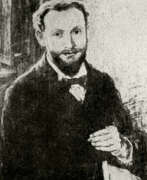

Solomon Yakovlevich Kishinevsky (Russian: Соломон Яковлевич Кишинёвский) was a Russian and Soviet artist of the late 19th and the first half of the 20th centuries of Jewish origin. He is known as a painter, graphic artist and teacher, a prominent representative of the Southern Russian school of painting.
Solomon Kishinevsky worked in domestic, portrait and landscape genres. At the beginning of his career, he was fond of German and Italian classicism, then French impressionism, but the first serious works he created under the strong influence of the Itinerants. His life sketches, scenes from the life of the urban poor were acutely social, the artist has a special attention to the everyday existence of the "little man.
Kishinevsky died presumably in 1941 during the Nazi occupation of Odessa.


Ivan Vasilievich Kliun (Russian: Иван Васильевич Клюн) was a seminal figure in the Russian Avant-Garde movement, a painter, sculptor, and art theorist associated with Suprematism, a movement that sought to break down art into its basic geometric components. Born in Bolshiye Gorki, Kliun was deeply involved with the avant-garde circles that revolutionized Russian art in the early 20th century. His journey into the art world took him through studies in Kiev, Warsaw, and Moscow, culminating in a long-standing collaboration and friendship with Kazimir Malevich.
Kliun's artistic contributions were vast, ranging from his exploration of color theories to his pioneering Suprematist works that featured geometric shapes against stark backgrounds. Despite the changing tides of political and artistic favor in Soviet Russia, Kliun remained committed to his abstract and purist visions, even when abstraction fell out of favor with the Soviet authorities in the late 1920s.
His works, characterized by a unique integration of light and color to enhance the depth and intensity of the abstract forms, are significant for their experimental approach to Suprematism. Unlike many of his contemporaries who shifted towards Socialist Realism under state pressure, Kliun continued his abstract explorations discreetly. Today, his works are recognized for their innovation and contribution to the avant-garde movement, with pieces displayed in prestigious collections like the Costakis collection and international exhibitions.
For enthusiasts and collectors interested in the avant-garde movement and Kliun's groundbreaking work, staying updated on exhibitions and sales of his art is essential. Sign up for updates to stay informed about new product sales and auction events related to Ivan Vasilievich Kliun and explore the depths of Russian Avant-Garde art.
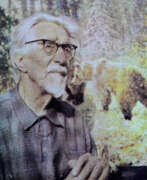

Alexey Nikanorovich Komarov (Russian: Алексей Никанорович Комаров) was a Russian and Soviet artist of the twentieth century. He is known as a painter, sculptor and animalist.
Alexey Komarov became famous for his illustrations in children's books and graphic works. His works cover a variety of subjects, from landscapes to animals. He has also created posters on a variety of subjects, including children's health care and the defense of the homeland during World War II. Komarov is also known for his watercolors as well as his sculptural works, including animal figures and busts. His works decorate various museums and exhibition pavilions.
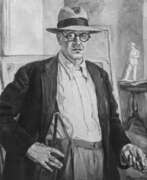

Pyotr Konchalovsky (Russian: Пётр Петрович Кончаловский) was a renowned Russian painter, a prominent member of the Jack of Diamonds group, which sought to blend modern French and German art with Russian primitivism. Born into an artistic family, Konchalovsky's career spanned several decades, during which he became known for his extensive use of color and innovative approach to composition. Influenced by Paul Cézanne, his works demonstrate a complex evolution of styles, from impressionism to socialist realism, without fully embracing abstraction. Konchalovsky's repertoire includes over five thousand works, comprising still lifes, landscapes, and portraits that contributed significantly to the development of Soviet realistic art. Notably, his artistry extended beyond his canvas; his family legacy includes notable figures in the arts, contributing to his lasting impact on both Russian and global art scenes.
His significant contribution to the avant-garde movement and his distinctive style, blending Fauvism and Cubism with realism, positioned him as a key figure in pre-Soviet and Soviet art. Despite challenges, including initial rejection in his homeland and a complex relationship with the Soviet regime, Konchalovsky's work received acclaim, including exhibitions at the prestigious Tretyakov Gallery. His legacy is preserved through the Petr Konchalovsky Foundation, ensuring his vibrant and dynamic works continue to inspire.
For collectors and experts in art and antiques, Konchalovsky's work offers a unique window into the evolution of Russian art during a turbulent century. His ability to synthesize various artistic influences while maintaining a distinctive voice makes his work a valuable addition to any collection.
To stay updated on sales and auction events related to Pyotr Konchalovsky's art, sign up for our newsletter. This subscription ensures you're informed about new opportunities to acquire pieces by this remarkable artist.
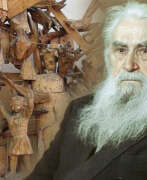

Sergey Timofeyevich Konenkov (Russian: Серге́й Тимофеевич Конёнков) was a Russian and Soviet sculptor, often hailed as "the Russian Rodin." Born into a peasant family in 1874 in the Smolensk region, he pursued his passion for art, studying at the Moscow School of Painting, Sculpture and Architecture, and later at the Academy of Arts. Konenkov's work was deeply influenced by his roots, leading to the creation of sculptures that blended Russian folklore with Hellenic and Russian culture.
Konenkov's career took a significant turn when he moved to the United States in 1923, where he stayed for 22 years. This period was marked by his exploration of biblical themes, creating renowned works that depicted Jesus Christ, Christian prophets, and apostles. His notable commission of a sculpture of Albert Einstein by Princeton University highlights his prominence during this period. Upon his return to the USSR under Stalin's directive, Konenkov continued his artistic endeavors, receiving numerous accolades including the golden star of the Hero of Socialist Labour and the order of Lenin.
His legacy includes a vast collection of works, with some of his most famous sculptures housed in the Tretyakov Gallery and the museum dedicated to his works in Smolensk, established posthumously in 1970. The museum's foundation was laid with forty of his creations, showcasing his significant contribution to Russian and Soviet art.
For collectors and experts in art and antiques, Konenkov's sculptures represent a unique fusion of cultural narratives and a testament to his innovative approach to sculpture. His works continue to be celebrated for their depth, creativity, and influence on the art world.
To stay updated on sales and auction events related to Sergey Timofeyevich Konenkov's work, sign up for updates. This subscription ensures you're informed about the latest opportunities to own a piece of Russian and Soviet art history.
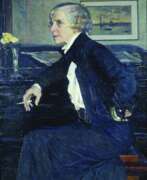

Elizaveta Sergeyevna Kruglikova (Russian: Елизавета Сергеевна Кругликова) was a Russian-Soviet artist, celebrated for her distinctive contributions to etching, silhouette art, and monotyping. Born into a St. Petersburg family with a deep appreciation for art, Kruglikova's talent blossomed early, supported by the artistic atmosphere at home. She honed her skills at the Moscow School of Painting, Sculpture and Architecture before moving to Paris, where she immersed herself in the city's vibrant art scene. From 1902, she experimented with etching, eventually becoming a notable figure in this field.
Kruglikova's Parisian period was marked by her work at the Académie de La Palette, where she both studied and taught, making significant contributions to the art of etching. Her return to Russia at the onset of World War I marked a new phase in her career, as she began exploring the realm of silhouette art, creating evocative portraits and scenes that captured the spirit of her subjects with striking clarity.
Perhaps most renowned for her pioneering work in monotype, a printing technique that allowed her unique expressivity, Kruglikova's art straddles the line between printmaking and painting. Her creations, ranging from the depiction of Parisian life to the vibrancy of the Russian cultural milieu, reflect a deep engagement with both her subjects and her mediums. The artist's ability to revive and innovate within traditional etching and printing techniques garnered her recognition and admiration, culminating in the dedication of the Fourth International Festival of Monotypes to her legacy.
Her works, characterized by a deep exploration of silhouette and monotype techniques, resonate with collectors and art enthusiasts to this day. Notably, Kruglikova was among the first Russian female artists to establish a studio in Paris, contributing significantly to the art scene there and back in Russia. Her late works include insightful portraits of fellow artists and poets, showcasing her mastery of silhouette style and positioning her as a key figure in the transition between printed graphic art and painting.
For collectors and experts in art and antiques, Kruglikova's legacy offers a fascinating glimpse into the innovative spirit of early 20th-century Russian and Soviet art. Her works not only reflect the artistic movements of her time but also stand as testaments to her individual creativity and technical prowess.
Stay informed about new sales, auction events, and exhibitions featuring Elizaveta Sergeyevna Kruglikova by signing up for updates. This subscription is your gateway to the world of a visionary artist whose work continues to inspire and captivate.


Alexander Vasilyevich Kuprin (Russian: Алекса́ндр Васи́льевич Купри́н) was a Russian painter and educator, renowned for his contribution to the "Jack of Diamonds" group and his profound influence on Soviet art. Born in Borisoglebsk, Voronezh region, in 1880, Kuprin's early life was steeped in the creative atmosphere provided by his family, moving to Voronezh in 1893. His educational journey through various art schools culminated at the Moscow School of Painting, Sculpture, and Architecture, where he was under the tutelage of Abram Arkhipov and Konstantin Korovin.
Kuprin's art evolved significantly over time. Initially inspired by French painting and Cézanne, his early works were marked by Cubist influences, characterized by a geometric simplification of forms. As one of the founding members of the Knave of Diamonds, he was at the forefront of avant-garde movements in Russia. However, his style underwent a transformation towards realism in the 1920s, influenced by his experiences in Nizhny Novgorod and later travels to Crimea. This period marked a departure from avant-garde to a focus on industrial landscapes and the natural beauty of the Crimean peninsula.
His significant works, often reflecting his fascination with the interplay of light, shadow, and form, are held in high esteem, with notable pieces like "Still Life With Blue Tray" and "The Beasal’skaia Valley" housed in the Tret’iakov Gallery. Kuprin's commitment to education saw him teaching at various institutions, including the Moscow textile Institute and the Moscow Higher Art and Industrial School, influencing generations of artists.
Alexander Vasilyevich Kuprin's legacy is not only in the beauty he captured on canvas but also in the minds he shaped through his teaching. His works, a testament to the evolution of Russian art through turbulent times, continue to inspire and captivate.
Collectors and experts in art and antiques can find a deeper appreciation for Kuprin's work by exploring his contributions to the Russian avant-garde and his influence on Soviet art aesthetics. For those interested in staying updated on sales and auction events related to Alexander Vasilyevich Kuprin, signing up for updates is highly recommended. This subscription will provide exclusive insights into the availability of his works, ensuring enthusiasts don't miss the opportunity to own a piece of Russian art history.
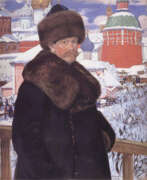

Boris Mikhailovich Kustodiev (Russian: Бори́с Миха́йлович Кусто́диев) was a distinguished Russian artist and painter, celebrated for his vivid portrayal of the Russian culture and way of life. Born in Astrakhan in 1878, Kustodiev's artistic journey began at a young age, leading him to study under the renowned Ilya Repin at the Imperial Academy of Arts. His works, characterized by their rich color palette and intricate detail, capture the essence of Russia's social and cultural fabric during the early 20th century.
Kustodiev's art is notable for its depiction of Russian peasantry, landscapes, and bourgeois celebrations, embodying the spirit and vibrancy of Russian folklore and traditions. His paintings such as "The Merchant's Wife" and "Maslenitsa" are celebrated for their lush visual storytelling and are housed in prestigious museums, including the State Russian Museum in St. Petersburg. These works reflect Kustodiev's fascination with the Russian merchant class and traditional festive gatherings, showcasing his skill in blending realism with a folkloric charm.
Beyond painting, Kustodiev's contributions to theatre and book illustration further demonstrate his versatile talent and deep connection to Russian cultural heritage. Despite facing personal challenges, including a debilitating illness that confined him to a wheelchair, Kustodiev's prolific output continued unabated, leaving behind a legacy that continues to enchant and inspire. His ability to capture the beauty and complexity of Russian life has made his work invaluable to collectors and experts in art and antiques alike.
For those intrigued by the rich tapestry of Russian culture and history as depicted through the lens of one of its most celebrated artists, we invite you to sign up for updates. Stay informed on new product sales and auction events related to the illustrious works of Boris Mikhailovich Kustodiev. This subscription is your gateway to the vibrant world of Russian art, offering exclusive insights and opportunities for collectors and enthusiasts.
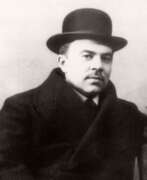

Pavel Kuznetsov (Russian: Павел Варфоломеевич Кузнецов) was a Russian artist, celebrated for his pioneering role in the Symbolist movement and his profound influence on the development of Russian modernist art. Born into the late 19th century, Kuznetsov's work spans painting, sculpture, and illustration, showcasing a unique blend of Eastern and Western artistic traditions.
Kuznetsov's art is renowned for its vibrant use of color, ethereal landscapes, and mystical themes. His distinctive style combines traditional Russian iconography with the innovative techniques of European modernism, making his work highly prized among collectors and art enthusiasts. Kuznetsov was a key member of the Blue Rose artist group, which sought to express the spiritual and emotional through art. This collective's contributions are considered seminal in the evolution of Russian Symbolism.
Among Kuznetsov's notable works are his dreamlike paintings of Central Asia, which brought a new dimension to Russian art by introducing themes and aesthetics from Eastern cultures. These pieces are not only significant for their artistic merit but also for how they reflect the cross-cultural exchanges of the early 20th century. Some of his masterpieces are held in prestigious institutions, including the Tretyakov Gallery and the Russian Museum, making them accessible to the public and subject to scholarly study.
For collectors and experts in the fields of art and antiques, Kuznetsov's works represent a valuable intersection of cultural heritage and artistic innovation. His contributions to the Symbolist movement and Russian modernism continue to inspire and influence contemporary art discourse.
To stay informed about new product sales and auction events related to Pavel Kuznetsov, sign up for our updates. This subscription is an excellent resource for collectors looking to enhance their collections with pieces by this distinguished artist. Join our community today and ensure you never miss an opportunity to acquire works by Pavel Kuznetsov.
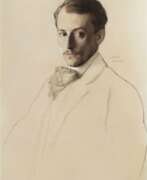

Yevgeny Yevgenyevich Lanceray (Russian: Евгений Евгеньевич Лансере), a Russian artist renowned for his graphic art, painting, sculpture, mosaic work, and illustrations, has left an indelible mark on the art world. Born in 1875 in Pavlovsk, Russia, Lanceray's art journey began early under the tutelage of prominent artists at the Drawing School of the Imperial Society for the Encouragement of the Arts in St. Petersburg. His educational odyssey continued in Paris at the Académie Colarossi and Académie Julian, places where he honed his artistic skills between 1896 and 1899.
Lanceray's association with the Mir iskusstva, an influential Russian art movement, saw him immerse in the Rococo's "sparkling dust," often drawing inspiration from 18th-century Russian history and art. Despite the societal upheaval following the 1917 Revolution, Lanceray remained in Russia, diverging from many contemporaries who chose to leave. His work during this period reflects a profound infatuation with Oriental themes, inspired by his time in Dagestan and travels to Japan and Turkey.
Perhaps one of his most significant contributions is the murals at the Moscow Kazansky railway station, where Lanceray's penchant for monumental painting and the integration of tempera paint showcased his mastery. Despite facing challenges with the Soviet regime and its constraints on artistic expression, Lanceray's legacy as a muralist, illustrator, and theater designer is undisputed. His recognition came in the form of the Stalin Prize and the title of People's Artist of the RSFSR, honors that underscored his contributions to Russian and Soviet art.
For collectors and experts in art and antiques, Lanceray's work represents a unique fusion of historical inspiration and personal expression, embodying the transitionary period of Russian art from pre-revolutionary aesthetics to Soviet realism. His murals, illustrations, and theatrical designs not only reflect his artistic versatility but also offer a window into the cultural and political shifts of his time.
To stay updated on sales and auction events related to Yevgeny Yevgenyevich Lanceray, sign up for our updates. This subscription will keep you informed about the latest discoveries and opportunities to own a piece of Russian art history.
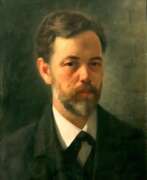

Andronik Grigorievich Lazarchuk (Russian: Андроник Григорьевич Лазарчук) was a Ukrainian and Soviet artist, born on January 15, 1870, in Ukhovetsk, Volhynian Governorate, and passed away on September 6, 1934, in Borzna, Chernihiv region. Known for his contributions to painting, teaching, and cultural activities, Lazarchuk's work primarily featured portraits, everyday scenes, and landscapes.
Lazarchuk began his artistic journey studying icon painting in Kovel and later in the Pochaev Lavra's painting workshop. From 1889 to 1897, he attended the Higher Art School at the Imperial Academy of Arts in St. Petersburg, where he studied under prominent artist Vladimir Makovsky. His artistic style was influenced by his early religious training, which is evident in his detailed and expressive portraits and landscapes.
One of his notable works, "Portrait of a Man," showcases his ability to capture human emotion and character. His other works include small-format paintings like "Reading a Letter" and "Family Group," which highlight his focus on everyday life and personal interactions. Lazarchuk also contributed to the decoration of Ukrainian churches, such as the Holy Trinity Church and the Cave Churches of Pochaev Lavra, and worked as an illustrator for magazines like "Native Land" and "Young Ukraine".
Collectors and art enthusiasts can explore Lazarchuk's legacy by signing up for updates on new product sales and auction events related to his works. This subscription will keep you informed about opportunities to acquire pieces by this influential artist.
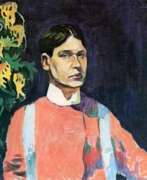

Aristarkh Vasilyevich Lentulov (Russian: Аристарх Васильевич Лентулов) was a prominent figure in Russian avant-garde art, celebrated for his distinctive use of color and innovative approach to Cubism. Born in Nizhneye Lomovo, Penza oblast, Russia, in 1882, Lentulov's early years were spent in a religious family, setting a foundation that would influence his rich and vibrant artistic style. His education at the art institutes in Penza and Kiev, followed by his studies under Dmitry Kardovsky in St. Petersburg, prepared Lentulov for a groundbreaking artistic career.
Lentulov's artistic journey took a significant turn when he moved to Paris in the winter of 1911. There, he was exposed to the works of leading French Cubists at the Académie de la Palette, including Henri Le Fauconnier. This period marked Lentulov's deep dive into Cubism and Orphism, influenced by his interactions with avant-garde artists such as Jean Metzinger, Albert Gleizes, and Fernand Léger. Upon his return to Russia, he became one of the founders of the Jack of Diamonds, a group that exhibited artists with "leftist tendencies" and embraced foreign, mostly French Cubists.
Lentulov's style uniquely combined the spatial concepts of Cubism with the vibrant colors of Fauvism, drawing on Russian folk art to create compositions that were both innovative and deeply rooted in Russian culture. His works, characterized by their luminous color and dynamic composition, played a significant role in the development of Russian Futurism and Cubo-Futurism. Notably, his involvement in theatrical projects, including set designs for the Kamerny Theatre and the Bolshoi Theatre, highlighted his versatility and creative genius.
Aristarkh Lentulov's legacy is preserved in his contributions to the avant-garde movement, and his works continue to be celebrated for their bold experimentation and vibrant expression. His paintings, such as "Saint Basil's Cathedral" and "The Belfry of Ivan the Great," are held in high esteem, showcasing his ability to capture the essence of Russian architecture and culture through a modernist lens.
Art enthusiasts and collectors recognize Lentulov as a pivotal figure in the evolution of modern Russian art. His innovative techniques and bold use of color have cemented his place in art history as a master of Russian avant-garde.
For updates on exhibitions and auction events featuring Aristarkh Vasilyevich Lentulov's work, sign up for our newsletter. Stay informed about the latest sales and opportunities to add a piece of Russian avant-garde history to your collection.
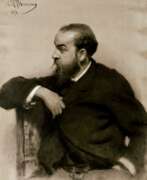

Rafail Sergeevich Levitsky (Russian: Рафаи́л Сергее́вич Леви́цкий) was a Russian artist of the last third of the 19th century to the first third of the 20th century. He is known as a painter-painter, photographer and teacher, professor of porcelain painting.
Rafail Levitsky painted genre paintings, portraits, landscapes, interiors, battle scenes from life. He is also considered the first artist in history to become a photographer. His many famous photographic portraits replaced models for painters, lithographers, illustrators, and engravers, as in the case of the portrait of Emperor Alexander III, which was reproduced on Russian banknotes.
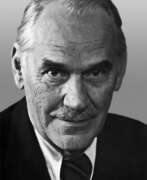

Alexander Mikhailovich Lyubimov (Russian: Алекса́ндр Миха́йлович Люби́мов) was a prominent Russian realist painter, illustrator, graphic artist, and art educator, celebrated for his significant contributions to Russian art, especially during the Soviet era. Born on February 25, 1879, in Paltsevo, Kursk Province of the Russian Empire, Lyubimov is renowned for his mastery in painting and graphics, which often depicted the societal and political landscapes of his time.
Throughout his career, Lyubimov was deeply involved in art education, teaching at prestigious institutions such as the Leningrad Institute of Painting, Sculpture and Architecture, and the Higher School of Art and Industry named after Vera Mukhina from 1934 to 1955. His pedagogical work influenced a generation of Russian artists, including notable figures like Alexander Laktionov and Yuri Neprintsev.
Lyubimov's works are housed in esteemed collections worldwide, including the State Russian Museum and the State Tretyakov Gallery, underscoring his status in the art world. His artworks, characterized by their vivid realism and complex interplay of light and shadow, continue to attract the admiration of collectors and art enthusiasts globally.
For those interested in exploring the works and legacy of Alexander Mikhailovich Lyubimov, subscribing to updates on exhibitions and sales related to his art could provide valuable insights and opportunities to acquire pieces from this influential artist. This subscription service focuses solely on new product sales and auction events related to Lyubimov, ensuring that enthusiasts and collectors are well-informed of the latest offerings.
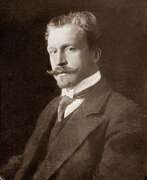

Aleksander Vladimirovich Makovsky, born on April 5, 1869, in Moscow, emerged as a distinguished figure in the realm of Russian Realist painting and graphic arts. His journey in art began within the noble confines of his family home in the Moscow province, where he honed his early skills. As a member of the esteemed Peredvizhniki, a group of itinerant painters, he imprinted his creative mark during a transformative period in Russian art.
Makovsky's oeuvre, comprising over 32 works, is a testament to his versatility and adeptness as both a painter and an illustrator. His Realist approach captured the zeitgeist of his era, infusing his canvases with a sense of immediacy and a connection to the Russian people and their experiences. His lineage—a noble dynasty known for its artistic contributions—further underscores the pedigree and cultural significance of his work.
The provenance of Makovsky's works includes an illustrious connection to Emperor Nicholas II, reflecting the high esteem in which his art was held among contemporaries. Such historical associations enhance the value and fascination of his pieces among collectors and art connoisseurs today.
For those intrigued by the legacy of Aleksander Makovsky and his contributions to Russian realism, further exploration of his works is a venture that promises rich rewards. As collectors and experts, delving into the world of Makovsky's artistry is not just an investment in art; it's an intimate encounter with history.


Kazimir Severinovich Malevich (Russian: Казимир Северинович Малевич) was a pioneering Russian artist, known for his profound influence on the development of abstract art in the 20th century. His nationality and specializations in painting, art theory, and teaching have cemented his place as a pivotal figure in the avant-garde movement, particularly for his role in founding the Suprematism movement. This movement, characterized by its focus on basic geometric shapes and a limited color palette, aimed to convey the supremacy of pure artistic feeling over the depiction of objects.
Malevich's art and theories have had a lasting impact on the course of modern art, challenging traditional perceptions of form and composition. His most famous work, "Black Square," epitomizes the essence of Suprematism. It represents a radical break from past art forms and a move towards abstraction, where the emotional and spiritual dimensions of art are prioritized. This piece, along with others like "White on White," has been exhibited in prestigious museums and galleries worldwide, showcasing Malevich's enduring legacy.
For collectors and experts in art and antiques, Malevich's works are not just paintings but are significant historical artifacts that embody a transformative period in art history. His contributions extend beyond his canvases, influencing sculpture, culture, and the broader artist school. His innovative approach to art has paved the way for future generations of artists, making his works highly sought after in the art and antique collecting community.
For those interested in the avant-garde movement and the evolution of abstract art, staying informed about Kazimir Malevich's contributions is essential. We invite you to sign up for updates related to Malevich, including notifications on new product sales and auction events. This subscription will keep you at the forefront of the latest discoveries and opportunities to acquire pieces connected to this revolutionary artist.


Sergey Vasilyevich Malyutin (Russian: Сергей Васильевич Малютин) was a distinguished Russian painter, architect, and designer, celebrated for his multifaceted contributions to the world of art and design. Born in Moscow in 1859 to a merchant family, Malyutin's artistic journey began after an exhibition by the Peredvizhniki inspired him to pursue art. His formal education at the Moscow School of Painting, Sculpture and Architecture honed his talents, leading to a diverse career that spanned painting, set design for operas and ballets, and architectural endeavors.
Malyutin is perhaps best known internationally for designing the first matryoshka doll in 1890, a seminal work that has become an iconic symbol of Russian culture. His involvement in the Arts and Crafts Movement influenced his work, integrating traditional Russian folk motifs into his designs and paintings. Notably, his architectural designs, including the Church of the Holy Spirit in Talashkino and the Pertsov House in Moscow, showcase his dedication to the Russian Revival movement, blending fantastic folk motifs with architectural creativity.
Throughout his career, Malyutin also played a significant role in education, teaching at the Moscow School of Painting, Sculpture and Architecture and advocating for Socialist Realism. His contributions to Russian art were not limited to his creations; he was instrumental in founding the Association of Artists of Revolutionary Russia, emphasizing the importance of art in societal development.
For those interested in exploring the legacy of Sergey Malyutin, his works offer a window into the fusion of traditional Russian art with the innovative currents of his time. Collectors and experts in art and antiques will find his contributions to Russian arts and crafts, especially his role in the creation of the matryoshka doll, to be of particular interest.
To stay updated on exhibitions and auction events featuring Sergey Vasilyevich Malyutin's work, sign up for updates. This subscription is an invaluable resource for enthusiasts looking to deepen their understanding of Malyutin's impact on Russian art and design.
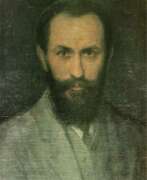

Anton Ivanovich Manastyrsky (Russian: Антон Иванович Манастырский) was a Ukrainian and Soviet artist of the twentieth century. He is known as a painter and graphic artist.
Anton Manastyrsky became famous for his genre paintings based on Ukrainian folk songs. His works are characterized by plasticity, rhythm and poetry. He also worked in the portrait genre, creating such canvases as "Portrait of Mother", "Portrait of Taras Shevchenko" and others. The master also illustrated books and worked in the religious genre, restoring the iconostasis in the Church of the Assumption of the Blessed Virgin Mary in Ancient Galich.
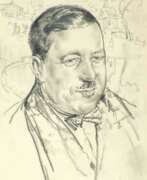

Ilya Ivanovich Mashkov (Russian: Илья Иванович Машков) was a Russian artist, renowned for his vivid and sensory-rich paintings, embodying the essence of Russian Neo-Primitivism. His journey began in the village of Mikhailovskaya, propelling from a humble background to becoming one of the most significant figures in the "Jack of Diamonds" group. His works are celebrated for their tangible, almost tactile quality, drawing viewers into a vivid world where colors pop and forms pulse with life.
Mashkov's notable participation in significant exhibitions across Europe and the United States, including the Salon d'Automne and the Venice Biennale, helped cement his status in the art world. One of his masterpieces, "Still Life with Fruit," fetched a record $7.3 million at a Christie's auction in 2013, underlining his critical and commercial acclaim. This painting, a prime example of Russian Neo-Primitivism, was unveiled at the inaugural Jack of Diamonds exhibition, highlighting Mashkov's pioneering role in Russian Avant-Garde.
Mashkov's contributions extended beyond his canvas; he was a dedicated educator, establishing his art school and later teaching at VKhUTEMAS. His influence is palpable in the collections of major museums, including the Russian Museum, which houses a diverse array of his works from vibrant still lifes to expressive portraits.
For collectors and experts in art and antiques, Mashkov's legacy offers a captivating glimpse into the evolution of Russian modernism. His works, characterized by their bold coloration and dynamic composition, continue to inspire and attract admiration worldwide.
To stay updated on sales and auction events featuring Ilya Ivanovich Mashkov's work, signing up for updates is highly recommended. This ensures you're always informed about the latest opportunities to acquire pieces by this master of Russian Neo-Primitivism.
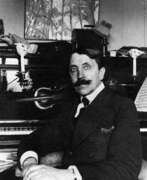

Michael Vasilyevich Matyushin (Russian: Михаил Васильевич Матюшин) was a pivotal figure in Russian art and music, known for his multifaceted talents that spanned painting, composing, and theoretical contributions to the avant-garde movement. Born in Nizhny Novgorod, Russia, in 1861, he initially made his mark as a musician, becoming the first violinist of the St. Petersburg Court Orchestra after studying at the Moscow Conservatory. Matyushin's artistic journey took a significant turn when he delved into painting, studying under various tutors and eventually meeting his future wife, Elena Guro, in an artist's studio. This partnership led to the creation of the "Crane" publishing house, fostering connections with futurists and other avant-garde artists.
Matyushin is perhaps best known for his theory of "extended seeing," which focused on the exploration of space and the interactions between color, form, and perception. This innovative approach aimed at extending the boundaries of human perception, a concept he developed further through his establishment of the Zorved group. His efforts were grounded in the belief that individuals could learn to perceive more than the visible, including information and events occurring outside their immediate sensory range.
His contributions to both the visual and musical arts culminated in notable works like the futurist opera "Victory Over the Sun," where his collaboration with Kazimir Malevich and Alexei Kruchonykh marked a significant moment in avant-garde history. After the Russian Revolution, Matyushin led an art class on Color at the Free Workshops, despite facing challenges from neoclassical revivalists. Despite these obstacles, he remained a prominent figure in Leningrad's Institute of Artistic Culture, where he continued his experimental work.
Today, Matyushin's legacy is preserved in the Museum of Avant-Garde in Saint Petersburg, housed in the very building where he lived and worked alongside other luminaries of the Russian avant-garde. For art collectors and experts, Matyushin's work represents a fascinating confluence of artistic innovation and theoretical exploration, highlighting his significant impact on both Russian art and the broader avant-garde movement.
For more insights and updates on Michael Vasilyevich Matyushin's influential works and theories, sign up for updates. This subscription will keep you informed about new product sales and auction events related to Matyushin's work, ensuring you're always at the forefront of the avant-garde art scene.
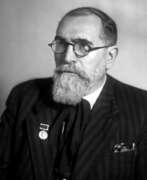

Sergey Dmitrievich Merkurov (Russian: Серге́й Дми́триевич Мерку́ров) was a Soviet sculptor-monumentalist of Greek-Armenian descent, celebrated for his significant contributions to the art world. Born in Alexandropol (now Gyumri), he ventured into art after leaving the Kyiv Polytechnic Institute due to a political scandal. Merkurov's education in art took him across Europe, from Adolf Meyer's tutelage in Switzerland to the esteemed studio of Auguste Rodin in Paris. His acquaintance with Vladimir Lenin abroad influenced his later works, including the famed Lenin statues across Soviet territories. Merkurov's mastery in creating post-mortem (death) masks for notable figures such as Leo Tolstoy and Vladimir Lenin, among others, showcases his exceptional talent and innovation in the field.
An adept of "academic modernism," Merkurov was also involved in the "Monumental Propaganda" program, through which he created numerous significant monuments, including the largest Stalin statues in the USSR. His works, such as the "Shooting of 26 Baku Commissars" and the "Death of the Leader," reflect his artistic prowess and ideological commitment to Soviet monumentalism.
Merkurov's legacy is preserved in the Merkurov Museum in Gyumri, which houses an extensive collection of his death masks, including the only original death mask of Lenin. This museum, opened in 1984 in his family house, stands as a testament to his life's work and influence. His contributions were recognized with titles such as People's Artist of the USSR and membership in the USSR Academy of Arts. Merkurov's works are part of several museum collections, including the State Tretyakov Gallery, underscoring his lasting impact on Russian and Soviet art.
Collectors and art and antiques experts who appreciate the depth of Soviet-era monumental art would find Sergey Dmitrievich Merkurov's works a remarkable study. For updates on exhibitions and auctions featuring Merkurov's work, sign up for notifications to stay informed about new sales and events related to this influential artist.
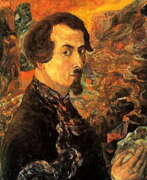

Vasily Dmitrievich Milioti (Russian: Василий Дмитриевич Милиоти) was a prominent Russian painter and graphic artist, whose artistic journey has left a significant imprint in the realms of painting and graphic design. Born into a culturally enriched environment in 1875, Milioti's oeuvre is characterized by its diverse application of mediums, including watercolor, gouache, and oil, showcasing his versatility and mastery over each.
Milioti's contributions to the art world are not only limited to his evocative artworks but also extend to his influential role within the artistic associations of his time. He was an integral member of "Blue Rose," a collective of artists that championed symbolism and mysticism in Russian art, and actively contributed to the "World of Art" movement. His involvement with the Moscow Association of Artists (Moscow Art Theatre) and the Group of 22 further exemplified his commitment to the development of Russian art.
Among his notable works, "The Poet" (1909) stands out for its intricate composition and the depth of its thematic expression. This artwork, like many of his others, reflects Milioti's deep exploration of human emotion and the philosophical underpinnings of existence, rendered through a unique stylistic approach that blends realism with symbolic elements.
For collectors and experts in art and antiques, Milioti's works represent not only the pinnacle of Russian symbolist art but also an invitation to delve into the complex interplay of colors, forms, and emotions that define the early 20th-century artistic landscape. His contributions have left an indelible mark on the history of art, making his works highly sought after by connoisseurs and institutions alike.
To stay updated on new product sales and auction events related to Vasily Dmitrievich Milioti, signing up for updates is highly recommended. This subscription ensures you're always in the know regarding the latest developments and opportunities to engage with Milioti's enduring legacy.


Count Vladimir Leonidovich Muraviov (Russian: Владимир Леонидович Муравьёв) was a Russian painter born in 1861 in St. Petersburg. Known for his evocative landscapes and hunting scenes, Muraviov studied under the distinguished landscape painters Mikhail Klodt and Julius von Klever at the Imperial Academy of Arts in St. Petersburg. His works are celebrated for their atmospheric qualities and his use of mixed media to capture the vastness and beauty of the Russian countryside.
Muraviov's paintings often depict serene natural settings, infused with a poetic appreciation for the Russian landscape. His notable works include "Forest at Twilight" and "An Elk in Snowy Landscape," which exemplify his mastery in portraying the tranquility and grandeur of nature. These pieces have been featured in prominent auctions, fetching significant prices, and are sought after by collectors for their detailed and immersive quality.
For those interested in Russian art and Muraviov’s exquisite depictions of nature, subscribing to updates can provide valuable information on new product sales and auction events related to his work. Stay informed about opportunities to acquire pieces by this distinguished artist. Sign up now to ensure you don't miss out on future offerings!
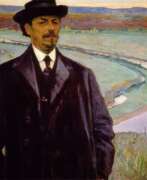

Mikhail Vasilyevich Nesterov (Russian: Михаи́л Васи́льевич Не́стеров), a distinguished Russian artist, was renowned for his unique contributions to the realms of painting and art, epitomizing the spiritual and cultural ethos of his era. Born into the vibrant milieu of pre-revolutionary Russia, Nesterov carved a niche for himself with his profound spiritual themes and innovative artistic techniques. His work, deeply rooted in Russian Orthodox traditions, reflects a meticulous blend of realism and symbolism, capturing the essence of Russian culture and spirituality.
Nesterov's artistry is celebrated for its ethereal quality, marked by a distinctive use of color and light to evoke a sense of divine presence. Among his most acclaimed works is the series on St. Sergius of Radonezh, a revered Russian saint, which not only showcases his technical prowess but also his ability to weave spiritual narratives into visual art. These pieces, housed in prestigious museums and galleries, continue to captivate art enthusiasts and collectors worldwide.
His legacy extends beyond his paintings, influencing generations of artists and imbuing Russian culture and art with a profound spiritual dimension. Nesterov's ability to transcend the mundane through his art renders his work timeless, making it a subject of study and admiration among experts in art and antiques.
For collectors and connoisseurs keen on exploring the rich tapestry of Russian art, Nesterov's oeuvre offers a window into the soul of Russia. We invite you to sign up for updates on new product sales and auction events related to Mikhail Vasilyevich Nesterov, ensuring you stay informed about opportunities to own a piece of this legendary artist's legacy. This subscription is your gateway to the world of art and culture, tailored specifically for those who appreciate the profound beauty and spiritual depth of Nesterov's work.


Anna Petrovna Ostroumova-Lebedeva (Russian: Анна Петровна Остроумова-Лебедева) was a distinguished Russian and Soviet artist renowned for her contributions to watercolor painting and woodcut art. Her artistic journey was marked by innovation and a deep connection to her cultural roots. She is celebrated for pioneering the woodcut technique in Russia, bringing a unique vision to the portrayal of cityscapes, particularly those of Saint Petersburg.
Educated at the Stieglitz School of Technical Drawing and the Imperial Academy of Arts under the tutelage of Ilya Repin, Anna Ostroumova-Lebedeva was among the early female alumni of the academy, reflecting her pioneering spirit in the art world. Her study period in Paris at the Académie Colarossi and with James McNeill Whistler at the Académie Carmen further refined her skills, especially in graphics, which she majored in upon graduating in 1900. Her initial series of woodcuts in 1901, commissioned by Sergei Diaghilev, featured Saint Petersburg's cityscapes, establishing her affinity for capturing the essence of urban environments.
Throughout the 1900s and 1910s, her travels across Europe significantly influenced her work, as she also ventured into book illustration. Her career later transitioned into academia, where she served as a professor at the Leningrad Institute of Painting, Architecture, and Sculpture. Despite the adversities faced during the Siege of Leningrad and losing her sight later in life, she continued to inspire through her art and dedication.
Her works, such as "Summer Garden," a color woodcut from 1902, showcase her expertise in capturing the interplay of light, shadow, and nature, reflecting the serene beauty of Russian landscapes. Her pieces are not only artistic achievements but also historical documents that offer insight into the cultural and aesthetic sensibilities of her time.
For art collectors and enthusiasts, Anna Ostroumova-Lebedeva's works represent a profound connection to Russian art history, embodying the evolution of artistic techniques and the enduring charm of Saint Petersburg's cityscapes. Her legacy in watercolor and woodcut art remains a significant point of reference for those interested in the intersections of culture, history, and art.
If you're keen on delving deeper into the works and life of Anna Petrovna Ostroumova-Lebedeva and staying informed about relevant sales and auction events, consider signing up for updates. This way, you'll remain connected to the vibrant world of art and culture that she so beautifully represented.


Ivan Nikolaevich Pavlov (Russian: Иван Николаевич Павлов) was a distinguished Russian and Soviet artist, celebrated for his significant contributions to engraving and painting. Recognized as a People's Artist of the RSFSR, Pavlov's work is a testament to his mastery of the arts and his dedication to portraying the complexities of Russian life and landscapes through his unique artistic lens. His art, which spans various themes and subjects, showcases a deep understanding of the Russian character and environment, making him a notable figure in the art world.
Pavlov's artistic legacy includes a vast array of works that have been featured in prominent galleries and collections, both in Russia and internationally. His ability to capture the essence of his subjects with precision and emotion has earned him a place among the revered artists of his time. Pavlov's contributions to the arts were further recognized in a monograph published in 1944, highlighting his life and work against the backdrop of the Leningrad blockade.
For collectors and experts in art and antiques, Pavlov's work represents not only an investment in Russian art but also a connection to the rich cultural heritage and history of the RSFSR. His engravings and paintings are more than just visually appealing; they are a reflection of a tumultuous era, seen through the eyes of an artist deeply embedded in his cultural milieu.
To stay updated on new product sales, auction events, and more insights into the works of Ivan Nikolaevich Pavlov and other eminent artists, consider signing up for updates. This subscription ensures you're always informed about opportunities to enrich your collection with significant pieces of art history.


Yehuda Pen (Russian: Юдель Моисеевич Пэн) was a Jewish-Belarusian artist-painter and teacher, recognized for his pivotal role in the Jewish Renaissance in Russian and Belarusian art at the start of the 20th century. Born on May 24, 1854, in Novoalexandrovsk (now Zarasai, Lithuania), Pen emerged as a significant figure, arguably paralleling Mark Antokolski's impact in sculpture. After moving to Vitebsk in 1891, Pen established the first Jewish art school in Belarus, offering training to many, including Marc Chagall, Ossip Zadkine, and El Lissitzky, who could not afford or gain admission to larger academies.
Pen's life was tragically cut short when he was murdered at his home in Vitebsk on the night of February 28/March 1, 1937, under unclear circumstances. His legacy, however, lives on through his works, primarily housed in Belarusian museums, including the Vitebsk Museum of Modern Art and the Belarusian National Arts Museum. Notable works include "Letter from America" (1903), "Old Tailor" (1910), and "Self-portrait with Muse and Death" (1925), showcasing his mastery in portraying everyday life and Jewish cultural themes.
Art collectors and enthusiasts keen on exploring the depths of Jewish art's evolution in the early 20th century would find Pen's work both intriguing and enriching. To stay updated on exhibitions and sales featuring Yehuda Pen's art, signing up for updates is highly recommended. This subscription will alert subscribers to new product sales and auction events related to Yehuda Pen, ensuring they don't miss out on owning a piece of history.
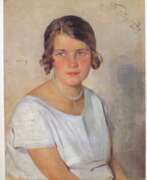

Mikhail Rodionovich Pestrikov (Russian: Михаил Родионович Пестриков) was a Russian and Soviet artist of the late 19th and the first third of the 20th centuries. He is known as a painter and teacher.
Mikhail Pestrikov was engaged in easel and monumental and decorative painting. He wrote portraits, created a number of paintings of biblical themes. The artist also carried out murals in houses, scientific institutions and churches.
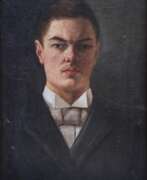

Kuzma Sergeyevich Petrov-Vodkin (Russian: Кузьма Сергеевич Петров-Водкин), a Russian painter, synthesized various traditions of global art, crafting a unique and deeply personal visual language. Born in 1878 in Khvalynsk, Saratov oblast, Russian Empire, Petrov-Vodkin is celebrated for his innovative approach to perspective, color, and composition, which positioned him as a pivotal figure in the art world of his time. He passed away in 1939 in Leningrad, now known as St. Petersburg, Russia.
Petrov-Vodkin's education in the arts took him from the Baron Stieglits School in Saint Petersburg to the Moscow School of Painting, Sculpture, and Architecture, where he was mentored by notable artists such as Valentin Serov. His studies abroad, including in Munich under Anton Ažbe, further enriched his artistic development. Notably, his marriage to Maria Jovanovic in Paris in 1906 marked a significant personal chapter, providing him with a lifelong companion and collaborator.
His work is distinguished by the use of "spherical perspective," a technique that distorts the drawing to emphasize the globe's curvature, making the viewer feel simultaneously distant and intimately close to the subject. This method, influenced by Byzantine iconography's inverted perspective, is evident in works like "Death of a Commissar" and "In the Line of Fire." Petrov-Vodkin's palette darkened over time, and his subjects diversified to include still life and portraiture, reflecting a broader exploration of theme and form. Despite facing health challenges, including pulmonary tuberculosis which limited his painting in later years, he remained prolific in other creative avenues, including literature, where his semi-autobiographical works are held in high regard.
His legacy is enshrined in the Russian Museum in St. Petersburg, which houses the largest collection of his works and dedicates a room to his art in their permanent exhibition. Additionally, a memorial museum in his hometown of Khvalynsk pays tribute to his contributions to Russian and Soviet art.
For collectors and art and antiques experts intrigued by Petrov-Vodkin's profound impact on Russian art, signing up for updates can ensure access to the latest sales and auction events related to his oeuvre. This subscription is a gateway to exploring the depth and breadth of Petrov-Vodkin's artistic achievements and ensuring enthusiasts are well-informed of opportunities to engage with his work.


Vasily Dmitrievich Polenov (Russian: Васи́лий Дми́триевич Поле́нов) was a distinguished Russian painter, celebrated for his contribution to landscape and historical painting. Born into an enlightened family in St. Petersburg in 1844, Polenov's artistic journey was nurtured by both his heritage and formal education at the Imperial Academy of Arts. His mastery in capturing the serene beauty of the Russian countryside and his innovative approach to biblical themes have cemented his place in the annals of art history.
Polenov's artistry was marked by his pioneering use of plein air painting, a technique that brought a fresh vibrancy and realism to his landscapes. Works such as "Moscow Courtyard" (1878) and "Overgrown Pond" (1879) not only showcase his technical prowess but also reflect his profound connection to Russian rural life and nature. His depiction of biblical scenes, notably in "Christ and the Sinner" (1886–87), broke new ground by intertwining these sacred stories with his love for landscapes, imbuing them with a unique sense of place and time.
A notable period in Polenov's career was his travels in Europe, where encounters with artists and cultures deeply influenced his work. Despite these influences, it was his Russian vistas that garnered the most acclaim, demonstrating his ability to infuse landscapes with a deeply personal and nationalistic sentiment. His commitment to art was intertwined with his belief in its power to evoke happiness and joy, a philosophy that guided his teaching career at the Moscow School of Painting, Sculpture and Architecture, where he mentored future luminaries of Russian art.
Polenov's legacy extends beyond his paintings. His estate, Polenovo, near Tarusa, has been transformed into a national art museum, ensuring that his contributions to Russian art and culture continue to inspire future generations. This dedication to the arts was recognized by his appointment as a People's Artist of the USSR in 1926, a testament to his enduring impact on the cultural landscape.
For art collectors and experts, Polenov's work represents not just aesthetic beauty but a rich narrative of Russia's cultural and natural heritage. His paintings, held in prestigious galleries like the State Tretyakov Gallery and the State Russian Museum, offer a window into the soul of Russian art, marked by a quest for harmony and a deep reverence for the natural world.
For those interested in exploring the works and legacy of Vasily Dmitrievich Polenov further, signing up for updates on new product sales and auction events related to his art can provide valuable insights into his enduring influence. This subscription is an opportunity to stay connected with the world of one of Russia's most beloved artists, ensuring access to the latest offerings and scholarly research surrounding his oeuvre.
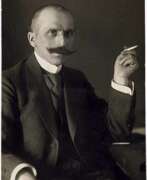

Vilhelms Kārlis Purvītis was a Latvian landscape painter and educator, celebrated for his profound influence on Latvian art and culture. Born in 1872 in the Kreis Riga area of the Governorate of Livonia, Purvītis is renowned for his mastery in capturing the neo-romantic atmosphere of Latvian nature through his paintings. He studied at the Imperial Academy of Arts in Saint Petersburg under Arkhip Kuindzhi, graduating with the Grand Gold Medal in 1897. His works, such as "Winter" (1910) and "Spring Waters (Maestoso)" (1911), showcase his evolution from Realism to Impressionism, influenced by European masters and movements like Art Nouveau.
Purvītis's contribution to Latvian art extends beyond his paintings. He founded the Latvian Academy of Art and served as its first rector from 1919 to 1934, shaping a generation of Latvian artists. His leadership roles at the Art Academy of Latvia and the Latvian National Museum of Art were pivotal in promoting Latvian art internationally, especially during the Republic of Latvia period. Despite personal losses, including the destruction of his house and many works during WWII, Purvītis's legacy endures through his influential teaching and the Purvītis Prize, established to recognize contemporary achievements in visual arts in Latvia.
For collectors and experts in art and antiques, Vilhelms Kārlis Purvītis's work represents not only a high point in Latvian landscape painting but also an embodiment of the country's rich cultural heritage. To stay updated on new discoveries, sales, and auction events related to Purvītis's work, signing up for updates is highly recommended. This ensures that enthusiasts and collectors alike are always informed about opportunities to engage with the legacy of this remarkable Latvian artist.


Arkady Alexandrovich Rylov (Russian: Аркадий Александрович Рылов) was a prominent Russian and Soviet painter, celebrated for his contributions to landscape painting and his role as an educator in the arts. Born in 1870 in Istobensk, Rylov moved to Saint Petersburg where he studied at the Technical Design School of Baron Schtiglitz and the Imperial Academy of Arts under Arkhip Kuindzhi. He was a key figure in movements like Mir iskusstva and the Association of Artists of Revolutionary Russia.
Arkady Rylov is best known for his landscape paintings, which are imbued with a sense of romanticism and depth, often featuring Russian nature and historical allusions. His works like "Green Noise" and "In the Blue Expanse" are celebrated for their artistic merit and have been recognized internationally, with "Green Noise" earning him honorary membership at the Paris Autumn salon. His landscapes, particularly those painted after the October Revolution, are also interpreted as symbols of revolutionary freedom.
His contribution to the arts extends beyond his paintings, as he played a significant role in nurturing future generations of Soviet landscape painters. Rylov's works and influence remain vital in understanding the evolution of landscape painting in Russia during the early 20th century.
For those interested in delving deeper into the world of Arkady Rylov and exploring his contributions to art and culture, signing up for updates on new product sales and auction events related to his works can be a valuable resource. This subscription will ensure that enthusiasts and collectors stay informed about the latest opportunities to engage with Arkady Rylov's legacy.
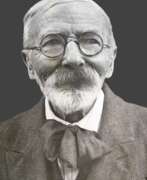

Nikolay Semyonovich Samokish (Russian: Николай Семёнович Самокиш) was a distinguished Russian artist and painter, renowned for his contributions to the realms of military, historical, and animal genre painting. Born in the late 19th century, Samokish's work encapsulates the vibrant culture and art of his time, showcasing his exceptional skills in sculpture and painting that have captivated art collectors and experts alike.
Samokish's oeuvre is celebrated for its meticulous attention to detail, dynamic compositions, and the ability to evoke emotion and narrative through visual art. His paintings often depict scenes of historical significance or moments of everyday life, rendered with a realism and intensity that bring the subjects to life. Among his known works, many are housed in prestigious museums and galleries, serving as testament to his enduring legacy in the art world.
For collectors and aficionados of art and antiques, Samokish's work represents a unique intersection of culture, history, and artistic excellence. His pieces are not only valuable for their aesthetic appeal but also for their historical context, making them sought-after additions to any collection. To stay informed about new product sales and auction events featuring Nikolay Semyonovich Samokish's work, we invite you to sign up for updates. This subscription is your gateway to exploring the exquisite artistry of Samokish, ensuring you don't miss an opportunity to own a piece of cultural heritage.
This exploration into Nikolay Semyonovich Samokish's life and work is based on a thorough review of available information, aiming to provide a concise yet comprehensive overview that resonates with art collectors and experts. His contributions to the field of art continue to inspire and attract admiration, underscoring the timeless appeal of his work.
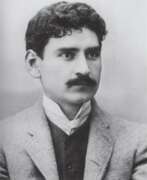

Martiros Saryan (Russian: Мартирос Сергеевич Сарьян), an Armenian painter, left an indelible mark on the art world with his vibrant landscapes, still lifes, and portraits that radiate the essence of Armenian culture and nature. Born in Nakhichevan-on-Don in 1880, Saryan's journey into the world of art was influenced by his studies at the Moscow School of Arts and notable artists like Paul Gauguin and Henri Matisse. His work is celebrated for its bright, bold use of color and a unique ability to capture the beauty of the Armenian landscape.
Saryan's artistic odyssey was marked by extensive travels across Turkey, Egypt, and Iran between 1910 and 1913, which enriched his palette and broadened his thematic scope. These experiences, coupled with his later contributions as a designer of the Armenian SSR's coat of arms and a theatre curtain, underscore his profound impact on Armenian national identity. Despite the challenges of the 1930s, Saryan's commitment to landscape and portrait painting never wavered, earning him prestigious awards and recognition within the USSR Art Academy and the Armenian Academy of Sciences.
Today, Saryan's legacy is preserved at the Martiros Saryan House Museum in Yerevan, where visitors can immerse themselves in his life and art. The museum showcases a wealth of his works, including renowned paintings like "Armenia" and "The Ararat Valley," offering a window into the culture and history of Armenia through Saryan's eyes.
For collectors and experts in art and antiques, the vibrancy and depth of Saryan's work offer a unique insight into Armenian heritage. Sign up for updates on new product sales and auction events related to Martiros Saryan, and explore the rich tapestry of Armenian art as seen through the masterful strokes of one of its greatest painters.
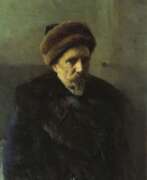

Vasily Yevmenievich Savinsky (Russian: Василий Евмениевич Савинский) was distinguished Russian and Soviet artist. Recognized for his mastery in psychological portraiture, historical painting, and religious art, Savinsky made significant contributions to the art world not only through his creations but also as a dedicated educator. He emphasized a rigorous study of nature, disciplined drawing, and the accurate depiction of natural colors in his pedagogical approach.
Vasily Savinsky's education at the prestigious Academy of Fine Arts in St. Petersburg under the tutelage of Pavel Chistyakov was marked by accolades, receiving both silver and gold medals for his exemplary work. His renowned pieces include "Ill Prince of Pozharsky Receives Moscow Ambassadors," "Judith and Holofernes," and "Portrait of Chistyakov," showcasing his prowess in various genres and mediums.
His influence extended beyond his own art, as he imparted his knowledge to students at various institutions, shaping the next generation of artists. Vasily Savinsky's legacy continues to be celebrated, with his works residing in notable collections and continuing to inspire art enthusiasts and collectors alike.
For those captivated by the artistic brilliance of Vasily Yevmenievich Savinsky and eager to delve deeper into his world of historical and psychological portraiture, consider subscribing for updates. By doing so, you'll stay informed about upcoming exhibitions, exclusive sales, and auction events featuring Savinsky's masterpieces, ensuring you never miss an opportunity to connect with the legacy of this remarkable artist.


Ivan Fyodorovich Seleznyov (Russian: Иван Федорович Селезнёв) was a Russian and Soviet artist of the last third of the 19th - first third of the 20th centuries. He is known as a painter of academic direction and a teacher.
Ivan Seleznyov worked in historical, portrait and domestic genres, as well as painted landscapes and still lifes. He became famous for his paintings on the subjects of Russian history, life scenes and realistic genre portraits. He also created and restored frescoes in churches in Kiev and was one of the organizers of the Kiev Fellowship of Religious Painting.


Mikhail Andreevich Sharonov (Russian: Михаил Андреевич Шаронов) was a Russian, Soviet and Ukrainian artist of the first half of the twentieth century. He is known as a painter, graphic artist and teacher.
As an artist, Mikhail Sharonov worked in the genres of portrait, landscape, still life and historical genre. He was also a professor and rector of the Kiev Art Institute. An important aspect of his life was art collecting; he amassed a significant collection of etchings by the Spanish artist Goya and donated 60 sheets from this collection to the Khanenko Museum in Kiev in 1941.
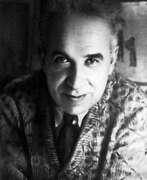

David Petrovich Shterenberg (Russian: Давид Петрович Штеренберг) was a Ukrainian-born Russian artist, recognized for his significant contributions to painting and graphic art. Born into a Jewish family in Zhitomir, Ukraine, Shterenberg's journey in art began in Odessa, leading him to Paris between 1906 and 1912, where he immersed himself in the vibrant artistic community. His studies at the Académie Vitti and interactions with notable artists like Kees van Dongen shaped his early artistic endeavors. Shterenberg's work, influenced by Paul Cézanne and Cubism, is celebrated for its expressive imagery, clear composition, and the strategic use of space.
Shterenberg's art evolved significantly over time, reflecting his deep engagement with the cultural shifts of his era. After returning to Russia post-1917 Revolution, he became an influential figure in Soviet art, leading the Department of Fine Arts at the People's Commissariat for Education and founding the Institute of Artistic Culture. Despite facing challenges under Soviet authority, which pushed him towards a more 'realistic' style, Shterenberg remained true to his unique artistic vision. His later years saw a return to themes of lyrical contemplation, notably in his Biblical Subjects series, completed before his death in 1948.
Today, Shterenberg's legacy lives on in major public galleries in Russia, including the Tretyakov Gallery, the Pushkin Museum, and the Russian Museum, as well as in private collections worldwide. His work encompasses a broad spectrum, from avant-garde experiments to intimate expressionist pieces, securing his place in the annals of modern art.
For enthusiasts and collectors alike, David Petrovich Shterenberg's oeuvre offers a rich exploration of early 20th-century art, marked by its innovative use of form and color, and its reflective engagement with the artist's cultural heritage and contemporary political landscape. Sign up for updates on new product sales and auction events related to Shterenberg, and discover more about this pivotal artist's contributions to the world of art.
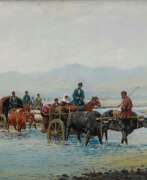

Richard Karl Sommer (Russian: Рихард-Карл Карлович Зоммер) was a Russian and Soviet artist of the late 19th and first third of the 20th centuries of German origin. He is known as a painter, graphic artist and watercolorist.
Sommer is most famous for his works created in Central Asia and Transcaucasia. He painted both domestic and battle scenes there, as well as landscapes of architectural monuments and old city neighborhoods. His paintings are characterized by clear composition and attention to detail, combining features of realism and impressionism, which made them popular among collectors and art connoisseurs.
The master was one of the founders of the Tiflis Society of Fine Arts.
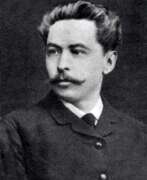

Alexei Stepanovich Stepanov (Russian: Алексей Степанович Степанов) was a distinguished Russian genre painter, illustrator, and art teacher born on May 6, 1858, in Simferopol and passed away on October 5, 1923, in Moscow. Stepanov's early life was marked by tragedy; he lost both parents by the age of five and was subsequently raised in a Moscow orphanage for children of military families. His formal education at the Konstantin Surveying Institute was followed by auditing classes at the Moscow School of Painting, Sculpture and Architecture, where he was influenced by prominent artists of the time.
Stepanov's art career flourished when he began exhibiting with the Peredvizhniki, a group of realist artists, and later helped found the Union of Russian Artists. His works often depict serene rural scenes and everyday peasant life, resonating with a mood of profound emotional depth. Notable works include "Moose Herd," acquired by Pavel Tretyakov, and "Morning Greetings," which earned him the title of Academician from the Imperial Academy of Arts. His work "The Swing" was notably acquired by the Carnegie Museums of Pittsburgh later in his career.
For those interested in the Russian art movement and genre painting, Stepanov's contributions are invaluable. His works can be viewed in major collections such as the State Tretyakov Gallery. To stay updated on exhibitions and sales related to Alexei Stepanov, consider subscribing to updates for collectors and art enthusiasts.


Yevgeny Ivanovich Stolitsa (Russian: Евгений Иванович Столица) was a Russian and Soviet artist of the late 19th century and the first third of the 20th century. He is known as a painter and graphic artist.
Yevgeny Stolitsa is best known as a landscape painter. He also painted portraits, historical and battle paintings. His works are distinguished by a fine transmission of the light and air environment, a free impressionistic style of painting, rich and saturated colors with lots of nuances and shades. According to critics, unpretentious rustic motifs in the artist's portrayal acquired a special poeticism.


Nikolai Nikolaevich Storozhevsky (Russian: Николай Николаевич Сторожевский) was a Russian, Ukrainian and Soviet artist of the first half of the twentieth century. He is best known as a landscape painter, representative of the Ukrainian avant-garde.
Nikolai Storozhevsky was one of the founders of the Association of Kharkov artists. After the disintegration of this group he participated in the creation of the creative association "Union of Arts".
